Don't wanna be here? Send us removal request.
Photo
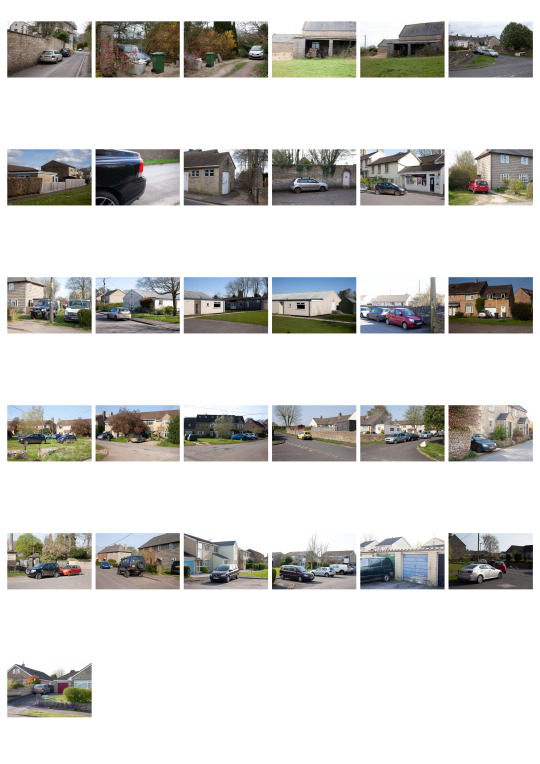
PHOT303 - Mileage May Vary - 5-9/4/2020
The adjustment to shooting digitally is well underway. I am only really used to this process when I am shooting for payed work, whether that is for the PCA:SU events or working for AYCH. It seems to strange to me that I am working on a personal project, and I can see those images instantly. Yet it is freeing to know that this is my only digital camera with only one lens to use, which is creatively limiting but with the knowledge of how to use that equipment.
The settings are pretty much on lockdown (pun intended), with the ISO being as low as possible (100) with an aperture of F8, with alternating shutter speeds depending on how the light is. At F8, most things are in focus with the distances I am working at, with the 50mm F1.8 STM being tack sharp before being effected by diffraction, which would start to set in with an extra stop at F11. The 5D also has a custom colour profile with the least amount of contrast to add to the faux-analogue look and feel, with the contrast and highlights being reduced in post production in LR.
All of the images are taken when I am on my daily allotted exercise around the village, which has a wide range of modern suburbia and quaint village life. A lot of Colerne is made up from fairly newly built houses from around the 1960′s, with the addition of the fairly typical Wiltshire houses built in the 1800′s. Both of these juxtapose each other, and look like their from different locations, but only are they really a stones throw away.

A Citroen ZX lies dormant in somebody’s driveway, surrounded by a bulk bag and a wheelie bin. This particular ZX has been sat for a while, and according to google earth it hasn’t moved all too much since 2013. This is most likely one of the 2041 recorded SORN ZXs according to howmanyleft.co.uk.
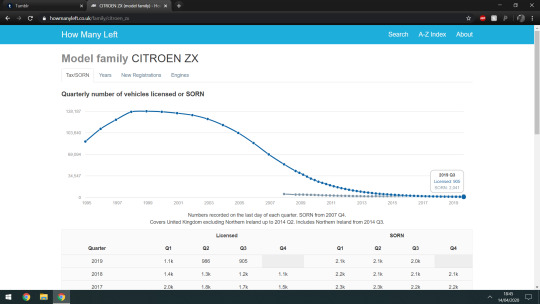
It seems a shame that a car which was seen extremely often, with at their peak in 1998 being 138,187 on the road, with the last quarter of 2019 seeing only 905 still driving our roads. Somehow almost double the amount of ZXs are SORN and off the road, just like this one. It might see the road again, but it could also be scrapped and then recycled.

A Toyota Celica and a Ford Fusion are parked next to a crossroads towards an entrance to Colerne. What piqued my interest was the black Celica which looks rather tattered and battered. This particular flavour of Celica was made from 1993-2000, also known as a T200. Something to note is that is has the wheels from the T230 which came a generation after this, made from 1999-2006. Without a registration plate, it is hard to define what model this is, as there were a few models with some being exclusive to North America and or Japan. This is most likely the AT200 verison, with the ST/ST Limited level trim. Places like these often give off an air of affluence and high standards, and seeing this Japanese sports car in a state of disrepair is almost like I am roaming around partially derelict estate. The surroundings however don’t reflect this, and contrast it with nicely presented houses and clean pathways.

5/4/2020
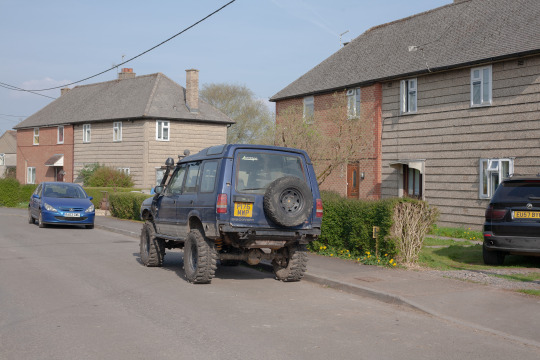
9/4/2020
I spotted this rather special Land Rover Discovery parked in a driveway, and I knew I had to capture it. The Discovery is usually a car reserved for the high flyers of the car world, with them normally lumbered with high prices and quality. Yet vehicles like that depreciate massively and become cheap to buy once they’re 10-20 years old. This is a Series 1 ‘Disco’, made between 1989-1998 with 2.0L petrol to 4.0L V8 engine options. This particular Disco has had a lift kit installed, with more aggressive tyres, bash bars and a winch. This means that this Disco has been converted to an offroader, which by the looks of its condition is used fairly regularly. Being in a fairly rural part of the country, there are plenty of areas that this can be utilised. This area isn’t as affluent as the rest of Colerne, with these houses looking like pre-fabricated post war or Council House offerings.

Thickwood is just over a mile away from Colerne, being a large estate made up with large house bristling with suburbia. The houses are nicely presenting with impeccable gardens and the cars sitting proudly on the driveway. They act as safe bubbles for the residents and are the key goal for many: to work hard, get a mortgage and own a house with disinfected counter tops and a nice car placed on the drive. These areas always remind me of OK Computer, as the themes of chasing a certain lifestyle and being a slave to capitalist ideals and expectations - which is a good link as OK Computer was recorded only a stones throw away from Colerne in St. Catherines Court. I also find it odd as I am acting as one of these suburbanites in a nice house and a clean car on the drive. Is this something I want? Is this expected of me? Do I need this? These suburban areas always remind me of Meeting People is Easy when No Surprises is shown on Sky News.

There is a certain cynicism within my work that reflects the lyrics of No Surprises. Whilst my work is documenting these cars that escaped the VSS and stood the test of time, it is also a commentary on our society and capitalistic tendencies to keep on spending, to own houses and cars all paid for by a job that we don’t like and slowly kills us. The elements of alienation from this lifestyle still lingers from previous projects as it is still felt by myself, and I think it will never leave me. It is interesting to me that I can manifest these feelings of alienation and estrangement in different ways, and it usually makes its way into what I do.

A Vauxhall Zafira found in its natural habitat of the suburban neighbourhood. For me, scenes like these heighten these alienated feelings, as these people have a house and a family. Vehicles like these warrant multiple children, as they were designed as MPVs (Multi Purpose Vehicles). These people have done what is potentially expected of them in life: they have worked hard enough to purchase a house, obtain a mortgage, work throughout the week and produce multiple children - Is that living? Do they enjoy it? Do they want this? These are hard to answer questions, and completely theoretical. But these are questions that I ask myself when in these settings. We live to certain expectations that is perceived within society and let technology rule what we do. The technology we use can be dangerous, with social media and mobile phones being constantly glued to our hands and our eyes. Some of OK Computer thematics is the rise in technology on the brink of the 21st century and it taking over our lives, become more and more robotic and it is becoming more real than ever. Who is serving who? Do we run this technology, or do we let it run is? These questions somehow run deep within a project that is inherently about the banal vehicles that escaped a scheme over a decade ago, yet they’re intrinsically linked to our society and its demons.
Whilst living in a suburban setting in the countryside is good to escape the encompassing pandemic, as well a offers some interesting photographic subjects, it also places some questions within me about how we live and what is expected of us. Do we really need to aspire to family living? Do I need to buy these things to make me happy? Why am I staring into this slab of glass with smooth animations and flashing lights? This could be the quarantine lockdown house arrest speaking, but I am questioning what life is and how we all live it. Despite the everyday mundanity going on, it manages to bring up questions to me that I can’t quite answer.
Despite being locked into a small village, there are a surprising amount of vehicles to photograph with some new ones appearing each day. I would have thought that shooting in such a small area once a day would severely limit what I could shoot, yet I am managing to capture much more than I expected. Even though I cannot shoot how I want to be shooting, I am enjoying the digital process more that I was anticipating. I can see the results near enough instantly and see any changes I make within that time. It is a lot cheaper, as I don’t spend anything to get my photographs - I just have to have space on my CF card and a charged battery.
0 notes
Photo

PHOT303 - Mileage May Vary - From Film to Digital
COVID-19 has initiated a lockdown for our nation, with many businesses closing for this time and many being held under house arrest. This also means that shooting film at the moment is not possible, as I cannot afford to send over multiple medium format rolls to be developed and scanned, with the addition of lab scans not being wanted for this project. This is turn means that I have to shoot digitally for the foreseeable future. I personally do not have a massive problem with it, but I would prefer to use the Mamiya 7ii which I have that now lives in my camera bag until June.
With no surprises, I am using my old faithful Canon 5D and the 50mm F1.8 STM which has served me so well for many many years. Despite the 5D’s age, it keeps on clunking over and creating really nice images. The 50mm F1.8 STM might be the cheapest prime that Canon offer, but it is still a stellar piece of glass when one is on a budget. It uses the same optical design as previous iterations, but uses some newer coatings to reduce chromatic abberations and flaring.
Shooting has been extremely limited, due to being stuck in a village in Wiltshire with no way to explore further locations. The lockdown has severely limited where I can shoot and what I can shoot. There are only so many pre-2009 cars in a small village, yet there is another portion to the north that is easy to walk to and possible to explore. This will happen in due time.

It is hard to re-imagine what this project is, and what it is to become. It is still the documentation of cars that escaped the VSS, but it is now narrowed down into a singular location. I also have to get used to shooting in a digital format, of which I haven’t used for a project since this time last year. I am having to work around using a camera that isn’t analogue, a different aspect ratio and resolution. In contrast, I do feel right at home with the 5D as it is the camera that I use for my professional work, and the camera that I have used for the better part of 4 years. I am still sticking to shooting more of the encompassing area, instead of zooming into the details of the cars, as I feel that the spaces around the vehicles gives more context to the photograph as more of a field study of the economical aspects to car ownership. Above, is a Toyota Prius and an MG ZR sitting proudly on somebodies driveway. They’re quite a juxtaposing mix, as the Prius is a car synonymous with environmentally friendly inclined motorists, and the ZR more of a boy racer demographic. Yet, they are both parked on a driveway of a nicely presented bungalow, with a pristine garden where an elderly gentleman resides.

I also like to document the areas where vehicles have been, but aren’t currently there. With this, there is a hauntological aspect to the images, as a spectre of the vehicles is around in the form of the tyre tracks left in the dirt, but they aren’t there. I also like the bungalows in this area, as there is a New Topgraphics aspect to the design of them. There is an interesting mix of newer houses, with an older house just top the left of centre with the chimneys showing.

The editing process is also rather different when it comes to a digital raw file, as there is so much information on the image that can be recovered and changed. With digital files, I like them to be a flat as possible to emulate the ‘film’ look. For this, I reduce the contrast to a little as possible, and reduce the highlights to have a larger dynamic range. I always find digital images to be incredibly contrasty when compared to an analogue photograph. It also makes the image rather washed out and pushes the details up slightly. I find a lot of large format images also have this quality to them, with the contrast being fairly low and the details extremely high. Not to say that digital images can compete with large format, but still. This process shall continue throughout the lockdown period, continuing with the same editing style, camera and lens.
0 notes
Photo

PHOT303 - Mileage May Vary - COVID-19 Update
COVID-19: The Elephant in the room. The end of December saw a Virus start to sprea across Wuhan, China. In the West, we were simply peering into China and seeing what the situation was, and making sure that this wasn’t going to spread to anywhere else but that location. Public information posters started to litter public areas notifying people if they had been in Wuhan within the past 14 days, and the symptoms of Coronavirus.
A couple of months pass, and cases started to pop up within the U.K, and the rest of Europe. During that time, people weren’t that bothered and it was seen as nothing more than the flu, as infection and death numbers from Influenza outweighed what Coronavirus could do. Personally during that time, I was one of those people who wasn’t all too concerned about it, as I had been through the whole Swine Flu and Ebola debacle and assumed, that this was going to be same.

(March 2020, Colerne)
Then people started to pass away, and people still stuck to the assumption that it wasn’t as bad as the Flu and went on with their usual business. This proved to be a silly move, as it transpired that people could have COVID-19 and show no symptoms and basically act as a carrier, spreading the illness from person to person. As the deaths and infections rose, people still didn’t care all too much and went with their normal daily doings. Countries in Europe started nationwide lockdowns to keep their population indoors and fight the spread, whilst we kept on going as normal. This would prove detrimental, especially when in mid March we were told to stay indoors, and people fled to beauty spots like beaches, national parks and the country side. People ignoring that advice could have been the straw the broke the Camel’s back, as more and more people were bundled together and potentially, could have spread the infection even more than before, as droves of people flooded into Snowdonia and Weston Super-Mare. This in turn created a nationwide lockdown of our very own, with the Government pleaded all to stay indoors, and only go outside for obtained key supplies and one form of exercise per day. Despite this, people still ignore the Government’s plan to stop, or slow the spread of COVID-19.
The pandemic has caused some issues when it comes to this project, and our third year as a whole. Firstly, I am not able to get the photographs as I would like to get, as I am only allowed outside once a day, and I am staying in a village in Wiltshire with a very limited selection of vehicles to photograph, with the inability to drive anywhere due to the lockdown. Another issue is shooting film, as nowhere local can develop film, and I would have to rely on postal orders. Whilst I can do this, I do not have anything to scan the film with, and I cannot afford to have a lab scan it for the amount that I would like to shoot. In addition to this, I do not want to have a lab scan my film, as the quality wouldn’t be consistent with the rest of my work. This is rather annoying, as I have the Mamiya 7ii booked for the entirety of Easter with the 65mm F4. I am shooting film along side my 5D (which I thankfully brought with me when we escaped).

(March 2020, Plymouth)
The other issues mainly centre around the university itself, and the decision to move everything to a digital submission, and our summer show/Free Range being totally up in the air. With a digital submission, this would mean that physical media would be made totally redundant, making photobooks, zines and prints useless within this climate. These would most likely take the form of a digital platform to show the work, with the addition of digital photobooks and zines. Annoyingly the deadlines are staying the same, which I feel is a shortsighted and downright stupid decision. A pandemic has spread across the world, with many in financial difficulty or simply not being able to access materials which is paramount to creating work. Some students don’t have a good enough internet connection for digital work, and some students would need to access parts of the university to do their work, like 3D Crafts and glass blowing. With photography, it isn’t too bad of a transition, but it can still cause massive disruptions with some of our cohort having to totally change their work. Thankfully, we do have a blanket E.C (Extenuating Circumstances) across the whole of the college with extra time given to third year students. This is a good thing, as we will all have to adjust to fully digitally submitted modules for this semester. I do not think that we would be able to adjust to this format, and be able to keep the same deadlines. Our deadlines have been extended to August 2020, which should be enough time to adapt our projects during this pandemic.
Now, we will have to wait to see how our modules will be adapted to fit this all new digital submissions. I would have thought that they would have to have a journal, or blog, such as this. There will probably be something like a digital exhibition space, seeing as our summer show and Free Range will most likely be postponed to a later date, with the addition of digital photobooks and or zines. For me, this is a viable option as this blog shall continue through PHOT303 regardless of the deliverables - yet this will be the last time it shall be used. Now is time to stand by to standby for any updates with our redacted deliverables.
0 notes
Photo

PHOT303 - Mileage May Vary - 14/3/2020
This day was meant to be a trip to the Exeter Phoenix with Louise, looking at some art work and some moving image, yet a spectre loomed over the day, and the future. I decided to bring along the Mamiya 7ii on my travels, and load it up with a fresh pro pack of Kodak Portra 160 (before the price went up!).
Just as I arrived at Exeter St Davids, I had a call from Louise explaining that she had to go home and self isolate. The Coronavirus (COVID-19) was beginning to become a concern to the nation. This had been bubbling for a while, and the news started to report cases of it in China in late 2019 and early 2020. It had made it’s way to the U.K, and confirmed cases were being reported. Currently (that being 27/3/2020) it has worsened and the whole country is in lockdown, which is in turn being enforced by the police services. Yet this whole situation deserves it own post explaining the changes due to this. Back to our normal broadcast.
Since the trip had been cancelled as soon as I arrived, I took t upon myself to meet up with my old friend, Thom, as he is an Exeter resident. He had never seen a 7ii in the wild, so he was in awe about the camera. I had a few hours to spare, and I thought that the singular roll of Portra would have lasted me all of that time. And yet, I shot it all within about 30 minutes of starting it.

Another Vauxhall Combo, parked on somebody’s driveway on Eldertree Gardens, which is next to St. Davids Hill. The hill coming up from St Davids station is long and steep, but it saves waiting around the station for 40 minutes for a 120 second train ride into Exeter Central. The hill is tiring, but it only takes a few minutes to walk and it is good exercise. I almost walked past this Combo, but I have always enjoyed the design of these houses, and they are oddly nostalgic looking to me. If that Vauxhall Combo was swapped with something a bit older, I would think that it would be hard to decipher when this photograph was taken. I decided to stop down the lens to around F8 this time around, to get more in focus and to increase the sharpness of the 80mm F4. And I do have to say, it just gets sharper the more it is stopped down. Even when these are scanned with my Canoscan 9000F Mkii (previously written about and despised), they’re amazingly crisp. I have also found a size of negative that the scanner seems to work well with. 35mm scans always looked really bad, but it seems that the bigger the negative, the better quality the scan. Everything I have shot with the 7ii has been scanned using the Canon at 2400dpi. This might be a high dpi to be using, but it also collects a lot of the detail that I would like to retain.

I met Thom in town, grabbed a strong black coffee and we walked around the roads around the quay. And to the surprise to me, there was a lot of scenes that worked so well for MMV, hence why the roll didn’t last all too long. Here, is a Fiat Panda and the legendary Fiat Coupe. Just like the Alfa Romeo GTV, Fiat’s do have some questionable quality control and electrical choices, yet they’re fantastic cars. The Coupe was a model Fiat made during the 1990′s, which is a rare sight in this day and age. They are somewhat of a modern classic with what seems to be a cult following, with the most popular model being a turbo five cylinder, propelling the Coupe to 62 mp/h in 6.3 seconds. And just like the Rolls-Royce in the previous shoot, the cars seem to juxtapose the setting, yet fit in quite nicely.

Just up the road from the Fiat’s was this rather odd Renault Megane sedan. These Megane’s are usually hatchbacks, so it is a rare sight to see them in their sedan layout. This is also the only shot to include cars older than the proposed 2009 Scrappage Scheme. The bright white Megane contrasts the overgrowth, as well as the grubby Fiat 500. i wanted the Megane to take centre stage in this photography as it’s an oddity which isn’t seen all too much, and with a quick database check, it’s possibly the cleanest 2003 Megane around, with only 83000 miles, and passing every MOT apart from a few with minor issues. It is nice to see this Renault, baring down on 20 years old standing the test of time.


The final two shots are of the same Ford KA parked outside Watergate, above the quay. The KA is also a design that has stood the test of time, with the KA’s design originating from the early 1990′s, and being introduced in 1996. It is hard to believe that this design is of a similar age to me, as it looks, even today, to be modern and contemporary. As I took the first photograph (top), Thom was towards the back looking towards the block of flats, with him saying: “oh dude this is the one”. With one shot left, I had a look and he was right! It is possibly my favourite image to date and perfectly sums up what I want to be doing with this project. It manages to document the ageing, banal and boring cars that litter our urban landscape, as well as the urban landscape itself. I also like the addition of Kodak Portra 160. Despite it being less versatile than it’s 400 counterpart, it is a lot cheaper and finer grained. I do like the film’s overall aesthetic and quality, and it seems to match well with the Mamiya’s lenses.
The advent of Coronavirus has put a spanner in the works in terms of image creation for MMV. This was the last roll that was shot before social distancing, self isolation and quarantine was a regular occurrence and a requirement. This could mean the shooting the Mamiya 7ii could be placed on the back burner, and shooting digitally could be the only way that this project can progress. This does seem to change how I shoot, and I fear I won’t be able to create the work that I want to be able to create. I will however be shooting the 7ii at the same time as the 5D, and getting it developed when I am able to get back to Plymouth. I am of course able to send film off to be developed and scanned via postal order, but I cannot afford this with the amount that I am shooting, seeing as it is around £15-£20 per roll in total. So I shall develop the rolls at my local lab, and scan them at home when I am able to get back home.
0 notes
Photo
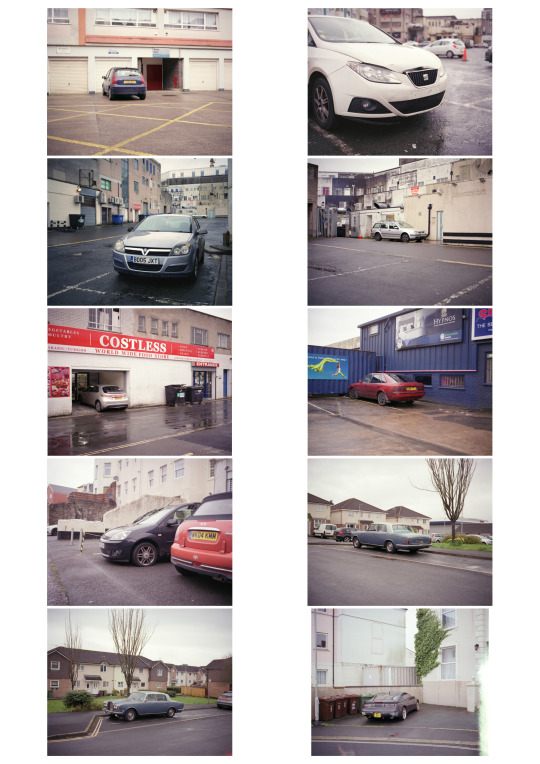
PHOT303 - Mileage Mary Vary - 4/3/2020
I decided to swap out the Mamiya 7ii that didn’t work, for one that finally did! But this shoot didn’t go without an issue. Now that I had a working 7ii to use, I was excited to see what I was going to create. I decided to take it upon myself, to head back to using expired film to see that I could create. I have had very good success with expired Fujifilm stocks, and loaded up the 7ii with a roll of Fujifilm Superia 400, which expired in 2012. With this in mind, I over exposed the film by a stop by metering the film at 200 iso.

A Citroen C3 is parked at Morley Court. This is one of my favourite locations in Plymouth, as it feels so removed from Plymouth as a whole. It is a housing estate that is plonked in the centre of town, towards the end which is lower on the social/economic scale. I find it interesting that the location reflects on the conditions of the vehicles, as the lower the perceived class of the area, the condition of the vehicles worsen and the age of the vehicles also increase. This would mean that the individuals on lower incomes, can’t necessarily afford to have a newer vehicle and keep it in a better condition. I find it interesting to shoot in a variety of locations that seem to justify this by documenting what lies within the specific areas.
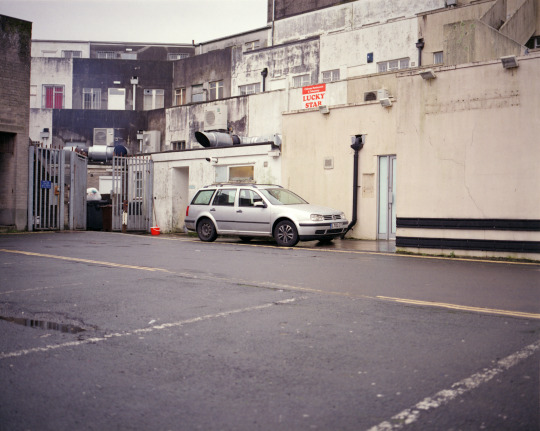
A Volkswagen Golf Estate MK4 is parked in the car park behind Lucky Star, which is on Raleigh Street. The whole area is an expansive network of grubby post-war buildings, which here are the backs of business and extractor fans. The particular Golf isn’t in the best of conditions, with missing wheel trims and an array of dents and scratches. I fell that this car manages to reflect on the nature of the surroundings. The 7ii also manages to pick up the small details, like the exhaust tube on a building to the left, forcing out a plume of blue smoke.
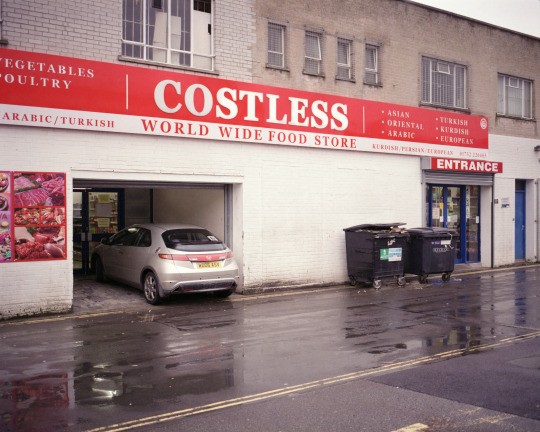
The eight generation Honda Civic was a far cry from previous iterations in terms of it’s design. Just like the MK3 Golf, it was a more more rotund compared to it’s earlier flavours. This immediately caught my eye, as the Civic managed to match the facade of Costless. I also did like the ‘Cost Less’ managed match the theory of the Vehicle Scrappage Scheme being used to boost the economy after the 2008 Financial Crisis. Again, the Mamiya manages to pick up so much detail within the scene, when the items within the shop itself. I also enjoy how I compose my work with this camera, as it does put me back into the mindset of capturing the scene, rather than just the vehicle being the main focus. Speaking of which, I didn’t even stop down past F4, which is wide open for the 80mm. F4 is a fairly wide aperture for 6x7, and can create some shallow depth of field once you get closer to the subject. yet as these distances, there is some subtle fall off between the foreground and the cars that are now in focus.
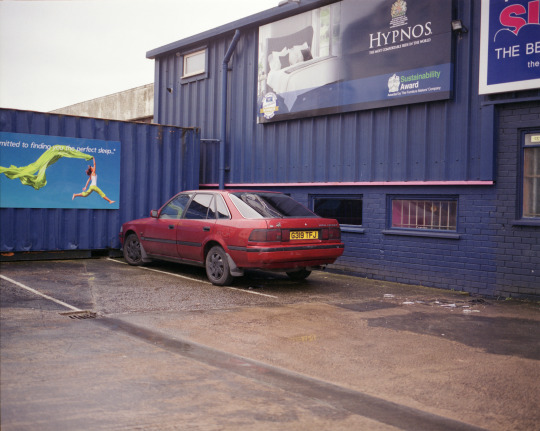
Something which used to be a familiar sight, a Toyota Carina. I remember seeing rather a lot of these when I was little, and they have disappeared from out road since, and most likely due to the Vehicle Scappage Scheme. It is hard to believe that this particular model was registered back in 1989, so it had been on our roads for over 30 years now. Yet, it manages to look rather well for it’s age, only really with some discolouration and some dodgy panel angles. This particular vehicle was parked outside a carpet shop in a side road that runs parallel to Ebrington Street. It was only later that it was pointed out the ‘Sustainability Award’ on the billboard above the Carina, which also coincides with the Scrappage Scheme. Just after I took this photograph and took the image of the Fiesta and the Mini, the potential owner came out of the building and was wandering his car and looking at me, almost inspecting. I assume he wasn’t all too pleased I was photographing his ancient Toyota.
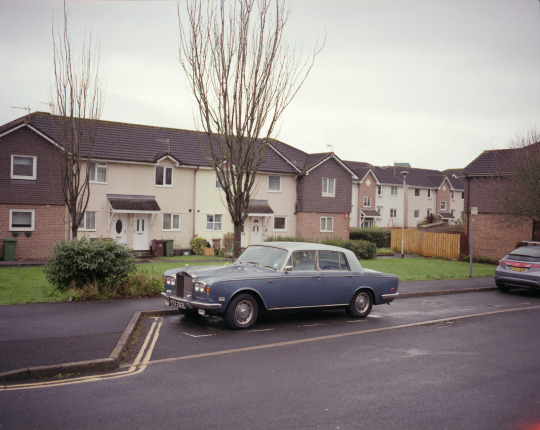
A bloody Rolls-Royce Silver Shadow! I have seen this whilst walking near White Friars Lane, which runs adjacent to Beaumont Road. The old Roller juxtaposes the newly built housing, yet almost manages to mix well into the scene. The Silver Shadow exudes high class motoring, with leather, walnut and chrome spilling from all areas. Whilst they were pricey purchases when they were new, they have depreciated so much that they’re almost affordable now...until it goes wrong or needs a service and then the bills start to add up, and the purchase of the vehicle becomes the cheapest part. There is also a noticeable, yet small amount of light leak on the lower right portion of the frame. During the shoot, I noticed that winding on the film didn’t feel entirely right. It felt as if it wasn’t winding as it should, and as I wound the roll to finish it, and opened up the back, I noticed that the roll wasn’t as tight as it should be, and was noticeably fatter. I suspect that this was due to the age of the film, and a potential comparability issue between the film and the spool that was left in the 7ii when I collected it. This can happen with 120 film and sometimes there is an issue, despite this being the first time I had encountered the issue.
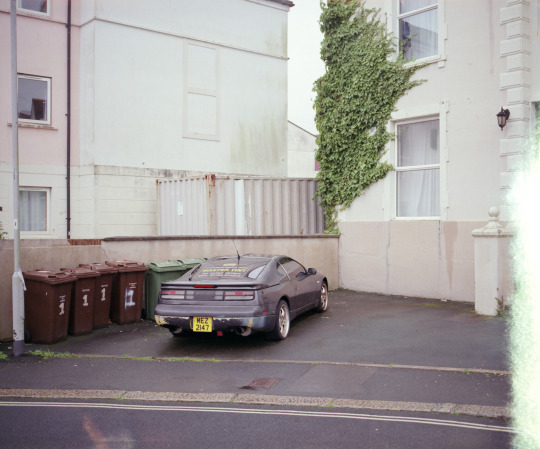
Here you can see the extent of the damage from the loose roll, with some light leak and fogging onto the last frame. This is the most affected image, but it is recoverable just by cropping. This photograph of a Nissan 300ZX advertising a window tinting company immediately looks like something Tom Westbury would have taken, with similar tones and composition. I am not sure how the 7ii does it, but the vertical distortion is always well corrected and always seems to by straight. It makes me wonder that all those times I wrote about Westbury’s work and the post production, it could have very well just been done in camera. I suspect that as 6x7 is such a large negative, it is easier to get the vertical lines straight as they should. The 300ZX is also an interesting vehicle, as it is a part of Nissan’s Z line of sports cars which also seemed to take a design change compared to the previous models. They are also a rare vehicle in this day and age, with many being molested by tuners or for the very few, kept nicely. I have never personally seen this car move, and this would be because it is currently SORN. With a quick check with the Government database, this is a 1990 model and was first registered in 2004, making this a grey import from Japan. This particular ZX is in a state of disrepair, with faded paint and a variety of dents and scratches. It also features some exhausts that the Channel Tunnel would be jealous of and some hideously dated alloys.
At last! A successful roll of film that resulted in some shots that I am proud of. It has been a long time since I had shot something and felt good about it. For a long time, I had become estranged from what I had shooting, and in all honesty, didn’t entirely enjoy what I was shooting for PHOT301. It wasn’t what I had envisaged and I am only just starting to get on my feet in regards to how I am making my work. And this is mainly down to using the Mamiya 7ii, as it puts me in the mindset of creating work and in it’s outcome, something that I really enjoy. The experience of using the Mamiya is great, and I cannon wait to see what else I can create this medium format beast. Yet I would like to be able to use different lenses, like the 65mm F4.
0 notes
Photo

PHOT303 - Mileage May Vary - 2/3/2020
I decided to step up my camera selection, and used a camera that I have always wanted to use. The Mamiya 7ii is, for me, the perfect film camera. The 6x7 images are massive, with an insane resolution for a camera that is not that much bigger than your average DSLR. The lenses, whilst at a maximum aperture of F4, are incredibly sharp and offer a nice range of focal lengths. The rangefinder is nice and bright, as easy to focus...but I’ll get onto that soon.
The 7ii was loaded up with a roll of Kodak Ektar 100, and we were ready to go! Oh hang not just yet as it was given to me without a working battery - never mind I shall go and buy one (the first image was in Russell’s shop just after I put a new battery in it). Once the 7ii was up and running, it went like a dream. The Ektar was also an interesting choice, as it is a contrast compared to the Portra range of films which is usually attributed with this camera. Portra is usually rather low contrast and washed out, when Ektar is saturated and full of popping colour. Although Ektar is a finely grained, sharp and nails colour negative film which is actually quite versatile.

There was one glaring issue with this particular Mamiya: the rangefinder wasn’t calibrated properly so when the patch in the viewfinder said it was in focus, it wasn’t. Rangefinders work in a different way to SLRs, in that you aren’t looking through the lens to take to photograph. The lens operations a cam, which then is in turn connected to a series of mirrors that form a patch in the viewfinder, which is mean to be calibrated to the lenses focus. The lovely moist road of this photograph is in focus, but the Royal Mail Vauxhall Combo is just enough out of focus to be noticeable. This was a reoccurring theme spanning the majority of the roll, only becoming slightly better when you get closer to the subject.

And again. The road - mainly the double yellows - are in focus, perfectly fine. Yet the Ford Fiesta is ever so more out of focus, compared to the Combo. This was highly irritating as I was enjoying using the 7ii for the first time, and thought that I had some good shots. It was making me shoot in such a way that reminded me of PHOT201′s Alienated Spaces, as I was tending to look more into the spaces, rather than the details of the cars themselves, although I did do that a few times.

Perhaps the most annoyingly missed shot was of this Alfa Romeo GTV. The GTV is quite a rare car now, as Alfa Romeo’s have a reputation from being amazing to drive, yet annoying to live with. Their reliability and build quality is, questionable as they mostly suffer from terrible electrical systems and metal so thin it may as well be one sided. The side of the skip is perfectly in focus, yet the GTV is again, ever so slightly out of the plane of focus just enough to be noticeable. Borrowing equipment from the ERC is always a risky one, as they aren’t always kept in the best of conditions. Despite this, it doesn’t take much to get their equipment serviced every one in a while to make sure that they are working to the best of their abilities. The Mamiya 7ii is an amazing piece of equipment which I just with I could afford, but it is sad when I get it and it doesn’t work as it should...and that I have to purchase a battery from a friend to get it to work.
This was my first toe tipping into the waters of 6x7 photography. Despite the rather annoying issue of it not focusing properly, it was great. The 7ii is such an enjoyable camera to use and it is hard to be angry at it. The negatives are massive for a relatively small camera, and they’re beautifully sharp to boot! The only real bug bear I have with it, is it’s extremely sensitive shutter button. It also have to dual purpose as a metering button, so when it is half pressed, it shows a meter reading of the scene, with then a full press taking the photo. But there isn’t much distinction from metering to photo taking. Apart from the shutter button, there are no issues to speak of. I would like to be able to use their other lenses to see what all this fuss is about with their sharpness. I would also like to use a different film stock - surprise surprise. Whilst I do like Ektar, it is too ‘punchy’ for the subdued approach to me work. I shall also swap out this particular 7ii for one that is hopefully working well.
0 notes
Photo
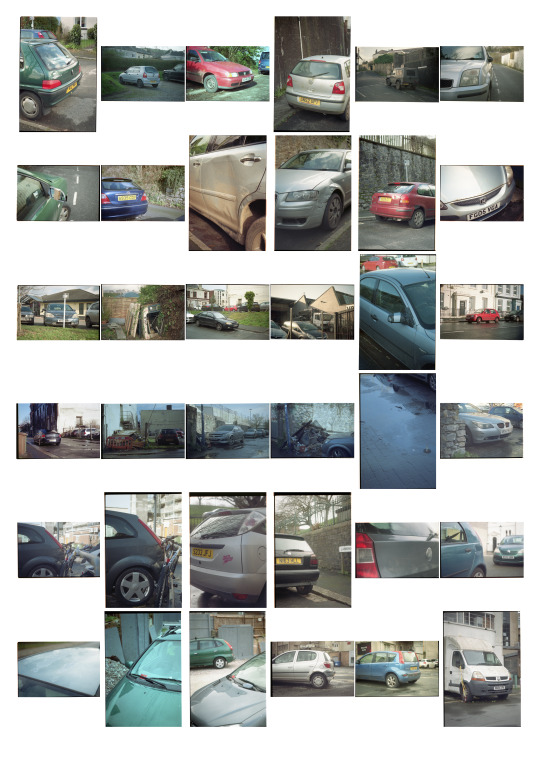
PHOT303 - Mileage Mary Vary - 4-23/2/2020
35mm cameras are certainly a favourite of mine, as they are compact, and cheaper than a new full frame DSLR. Medium format is my desired platform, but that doesn’t mean that 135 can’t be used from time to time.
This roll of Kodak Pro Image 100 started off in Totnes, with a camera that has been laying around for years...and it’s another Yashica. This time, its an TL Electro-X. This is an M42 mount 35mm SLR, with a simple stop down meter which has the coveted title of being the first camera with miniature lamps to let the user know that the exposure information. I thought I was use it for one more time before I eventually sell it, as it just sits around in a box never really being used, as my Pentax Spotmatic F is my main and only M42 mount camera. So this was a mix of a camera test, and another shoot for MMV. Although, I do not plan on using any 135 images for MMV, as they don’t hold the resolution and aesthetic for the project as well as the 120 format.
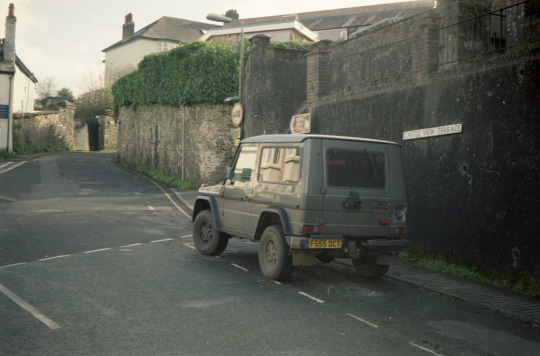
I firstly had one of my favourite lenses mounted to the Yashica: the Industar 50-2. This is a 50mm pancake lens, with a maximum aperture of F3.5 which was made in the Soviet Union. The lens is...optically different compared to newer optics and offers some certain nuances. Not to say that it’s rubbish, but it creates some interesting bokeh and is surprisingly sharp for what it is. They’re decently cheap to buy and millions of them were made, so they’re plentiful. Above, is a Mercedes 300 GD, which is one of many versions of Mercedes’ G series of vehicles. They’re robust and well made four wheel drive vehicles that can tackle harsh terrain, and even the hills of Totnes as it stands. The 50mm focal length is my go to focal length, as it can do close ups, and landscapes rather well for that I am doing. It is also easy for my to compose the shot, as it seem to see in this focal length in mind which usually makes it difficult to use anything other than 50mm.
The film is also quite nice. I have had several rolls for a while, and shot a few and not had them developed, so this served as the first one I ever had done. And fair to say, I rather like it. Pro Image 100 serves as a middle ground between the cheap as chips Kodak Colour Plus 200 and the expensive Kodak Portra range. It still manages to keep that Kodak golden glow but it doesn’t separate itself too much from their other offerings.

This is just around the corner from my home, where a number of 50ft Leylandiis where eventually fell after a year or two of discussion. Here are some Land Rover parts that lay in someones driveway and have eventually been taken over by the undergrowth. There is something inherently interesting about vehicles, and vehicle parts that get left on their own, and nature reclaiming it back to itself. I guess it is because it marks the end of that vehicles life, and it’s potential usefulness - although this isn’t always the case as they can always be reclaimed back to use and be restored with enough time and money.
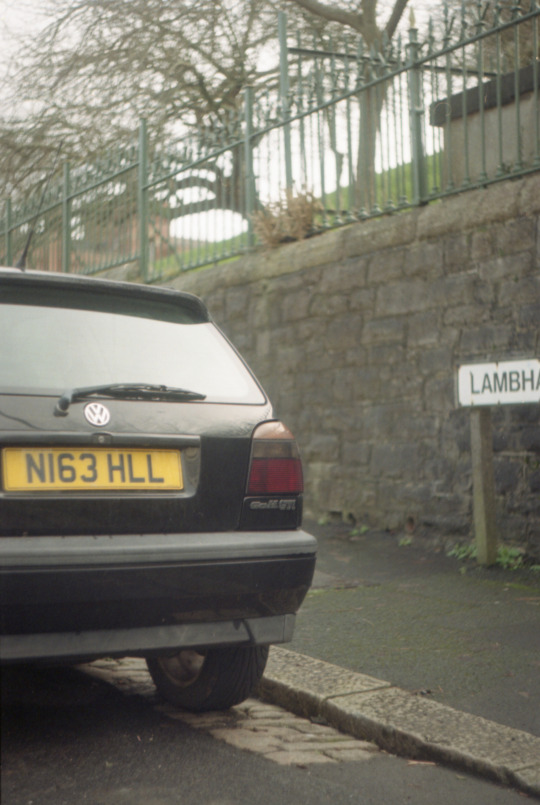
I didn’t finish the roll in Totnes, and it was eventually finished back in Plymouth with the addition of a lens change...but to another Soviet offering. I switched to the Helios 44-2, which is a highly regarded copy of the Carl Zeiss Biotar 58mm F2. The Biotar is one of many optical designs set out by Zeiss, with the Helios becoming a copy after the Soviet’s invaded Germany during the Second World War. Again, millions of Helios’ were made and they’re plentiful and cheap, yet they’re steadily on the increase as people are starting to realise that vintage glass is unique. The Helios is no acceptation, as it can create even wilder bokeh when the stars manage to align. Wide open at F2, it is often soft and ethereal, with no real sharpness until one stops down to F4. Above is a Volkswagen Golf GTI, but the often undesirable MK3. The first two GTIs were regarded as hot hatches, yet the MK3 was a lot larger and cumbersome compared to previous generations. Just like the 300 GD, not a great deal of nice examples exist, so it is nice to see that some are still kicking around, 20-30 years after their release.
Sadly, 35mm film just isn’t the format for this project. It doesn’t match up to the resolution that 120 offers, as well as the visual aesthetic that the larger negatives bring along with it. I personally see no advantage to use 135 when 120 is far superior in terms of resolution, aesthetic and creative limitation. Each photograph costs a lot more, and there is a lot less of them, so one has to be able to selectively choose what makes the cut, instead of having some leeway of what can make the cut.
0 notes
Photo

PHOT303 - Mileage Mary Vary - 13/2/2020
Medium format is such a great way of image making - it manages to mix large negatives with portability. I am able to step away from the sometimes limiting resolution of 135, but have the ability to use a camera that isn’t all to different in terms of weight and size.
I have in my possession, one of Aaron’s cameras. He very kindly let my borrow his first ever medium format camera: the Yashica EM. The Yashica is a 6x6 format 120 TLR camera, featuring their famed Yashinon 75mm F3.5 optics, found in many of their TLRs including the Yashica-Mat 124G. I have always had an issue with TLRs, as you aren’t viewing directly through the same lens the image is coming from, and waist level viewfinders can be awkward for me to use as everything is opposite and back to front. Having this camera with me would battle this feeling of awkwardness and potentially, make me enjoy square images again.
Me, Harriet and Aaron decided to go to Torpoint, mostly because me and Aaron wanted a pasty from Warrens, but all of the branches in Plymouth had shut down. I loaded up the EM with some partially old Kodak Portra 400, which expired in 2016. This isn’t massively expired, but I would soon find out that Kodak doesn’t keep all that well with their newer emulsions.

I have shot film that is a lot older that 2016 before, but there is something about the backing paper that Kodak uses that doesn’t seem to age all too well. Of course, this can be due to the conditions that the film has been left in, but three and a bit years of expiration isn’t usually something to worry about. As you can see from this photo of a Daewoo Matiz, there is some serious issues here. This is due to the backing paper sticking to the film and transferring its material. This can also transfer information from the paper including shot numbers and the film name. If it wasn’t for this expiration issue, I would have liked these images a lot more than I do now. This is certainly a game of Russian roulette when one is using expired films, yet I would have expected this from a film that was a decade or two out of date, rather than a few years. At least the lens of the Yashica has lived up to expectations.

A Vauxhall Agila (Suzuki Wagon R+ that has been rebadged) is parked new the waters edge. You can see the extent of the damaged film here, with the shot numbers and markers imprinted onto the emulsion. If I was going for an experimental approach, this would certainly be acceptable. Yet, it feels like I wasted a roll of film, and I could have had some keepers if the roll was a tad more fresh. But, these are the risks that are undertaken when expired film is used. Most of the time - in my experience - it has been totally fine with some slight colour shifts. I am not all too proud about this shoot, but serves as some experimentation and some water testing with TLRs and 6x6 images. And the answer may surprise you...
I still hate them slightly. Both of these aspects make the whole shooting experience very awkward for me, as I prefer to have the viewfinder up to my eye and not trying to force the photograph into a square. The waist level finder can be overcame with the addition of a prism finder, but the EM doesn’t support this and I can’t entirely afford a camera that does...currently. I feel like I am also trying to force myself to like 6x6 images too, and I can’t keep lying to myself, I really do hate it. There is a specific way to compose in that format, and I can’t get it to work for what I am doing, so I may just have to retire square format images from this project, and progress onto 6x7 instead. Expired film is also another thing to keep an eye out for, especially Kodak stocks. I spoke to Russell at Soperfect Images about it, and he has said to me that due to the backing paper they now use, they don’t keep as well as older stocks, or stocks from other manufacturers like Fujifilm.
I have learned to stay away from 6x6 TLRs, and expired Kodak films for now. The whole shoot wasn’t all too enjoyable, as I was using a camera that I didn’t massively enjoy, with the images coming out being next to ruined thanks to their manufacturing. Thankfully these are easy things to overcome, just by using a different camera and a different stock of film.
0 notes
Text

PHOT303 - Mileage May Vary - 16-21/1/2020
This roll started right before the end of PHOT301, with no time to complete it before the module finished. This wasn't an issue, as MMV hasn't changed and it will just pass through the submission and be the first set of images for the final-final major project piece. It also serves as a good platform from where MMV can go to, potentially acting as a stepping stone to how it will progress.
There is something about Cinestill 800T that just gets to me. It manages to render light so attractively and gives off a certain cinematic aesthetic - which is obvious - as it's motion picture film, modified to be processed in a lab. This shoot started on 16/1/2020, when me, Harriet and Aaron walked around Faraday Mill: a location I've wanted to shoot in before. It's incredibly still at night, with the odd gust of wind making some things rattle and a desolate reverbarance. It totally juxtaposes Faraday Mill during the day, with busy businesses and bustling car parks. The area is lit by lampposts and spotlights, which gleam upon the mise en scene.
The film was loaded into my Canon EOS-1 coupled with a 50mm F1.8 STM - which is now my go-to 35mm setup, as to me, it is an almost perfect version of my 5D for analogue shooting. Using this camera means that I am able to use all of my EOS lenses, like I can with my digital counterpart. The only real difference is (apart from being film), is that it has a single autofocus point (which is no issue as I have always used a single point in the centre and reframed each time) and that the body is poly-carbonate instead of magnesium. The autofocus is sometimes typically late 1980′s and will hunt around a bit, but for the most part it is fast and accurate.
On to the shoot. Faraday Mill, as previously mentioned, is a place that I have always been interested in shooting, but never really got around to actually utilising it. The whole area is a business park, with multiple tenants from mechanics to salons. At night, it has a certain desolate quiet which is inescapable. This theme of uncanny quietness was often disrupted by the final nine images on the roll, which were taken in Exeter in the very very early hours of the 21st January after the 301 submission. We all got to Exeter at around midnight of the 20th, and there were queues of people going into nightclubs, despite the freezing temperature.

The subjects have stayed the same for MMV over the transitory period - anything previous to being made in 2009 which has a certain aesthetic intrigue is fair game. This would mean that it must have some battle scars, weathering or be somewhat historical. This Vauxhall Rascal was one of the vehicles which was mentioned in one of the latter posts of PHOT301, when I didn’t have my camera with me to document it. Thankfully, the poor old Vauxhall doesn’t seem to move very far. For this, I wanted to incorporate more of the background, instead of solely focusing on the details of the vehicle for the entirety of the project. For me, it gives the vehicle more context, in addition to making it more lonely, in the sense that there is nothing really around it apart from the non-place that it resides.

I was finally able to photograph something of a scrap yard. Granted, it is across the road and at night, but I rather liked how the tree line, in addition to the fence causes a barrier between me and the yard. Stacks of old cars lie dormant, as the scrap handler will ultimately seal their fate.

Something that I need to really look at, is how I am composing my images and what I am including, From the feedback PHOT301, it seemed that there were two elements of image composition: close ups of detail and partial vehicle corner shots. This came across that I was unsure about what way to go with my images, as if there was some sort of typographical elements to my work, similar to Franck Bohbot’s Parked Cars or my photographs from PHOT104 Economy. Despite, this I would like to refine these two variations and have details of vehicle damage and full car shots including the environment surrounding it. An example of a mixture of these is the above image, showing an Audi A3 in the middle with a nasty dent in the boot lid. Here, I metered for the light shining on the boot lid, which is why the shadows are dark and the highlight from the background is blown out. Metering during night time is difficult, as it is inherently high contrast. The midtones are something I aim to meter for, yet metering for the shadows would allow for greater detail across the frame, but would need a tripod due to the longer exposure times. Midtone metering here was lacklustre, as the highest shutter speed was at around 1/60th.

When metering for the highlights, they become nicely exposed, with the midtones an shadows become muddy rather quickly, Here, I metered for the light coming from the street light reflecting on the bonnet of the Ford Focus, meaning the offside was underexposed. The shadows here are the worse effect areas, with the midtones managing to retain some detail. If I had metered for the shadows, I feel this would have been a stronger image. The sodium street lights also throw off the tungsten balanced film with an odd orange/green tint.

A Mercedes SLK is seen here parked with damage to the front bumper, nearside. You can see here how the sodium lights start to mess with the Cinestill, in addition to the slight fog causing some diffusion with the halation on the highlights. It was also around here where the weather started to cause an issue to my EOS-1...as the freezing temperatures managed to totally disable my viewfinder information, not allowing my to see what aperture, shutter speed or exposure value I was working with. Thankfully, the EOS-1 has an LCD screen on the top of the camera to display aperture and shutter speed, but not the value of the exposure. For the last few shots, the exposure was total guess work and it seemed to have worked well. Thankfully, when I got back into the car and it had warmed up, the display came back to life.
How does shooting at night improve, or add to my workflow? In short, it doesn’t. Whilst I enjoy shooting at night as it seems to feel more isolating, I do prefer to shoot during daylight purely due to the varying conditions that come with it. When the sun goes down, that’s it...its artificial light or you’re doing extra long exposures to see the stars. Cinestill is also something I love dearly with analogue photography, as it offers a unique and cinematic aspect to image making...yet it isn’t for this project. Just like the way black and white isn’t for this project, it just doesn’t fit the general aesthetic to this project, despite the fact that I love it. Black and white photography is great, but again it just isn’t the time. They all have their own respected uses, yet that time isn’t now. This does also juxtapose the inspiration of Vlad Tretiak’s images, as they are (for the most part) shot in the dark hours of the day. The addition of night photography also causes the exposure time to be longer, which can cause more logistical awkwardness with tripod use. Whilst this is necessary for such photography, I do prefer to simplify my gear and use as little equipment as possible, usually one camera and one lens.
For this, I would like to just have one camera per format (135 and 120). I would like to continue using the EOS-1 for 135, and either the Mamiya 7ii for 120 or the Yashica EM. The 7ii is more preferable due to the 6x7 image, as the square format, whilst has been used more often by myself, still find it awkward to use. WIth 6x7, it is slightly longer and retains a similar aspect ratio to 135.
For now, night photography will go on the back burner as it doesn’t entirely fit my aesthetic, and the body of work. Yet, I also have to whittle down how I am actually taking the images, and how they’re composed. I am always wresting the ways that I’m taking them - do I focus on the smaller details, or do I incorporate the entire scene?
1 note
·
View note
Photo

Mileage May Vary - A Proposal
Mileage May Vary is the documentation of cars that escaped the 2009 Vehicle Scrappage Scheme set out by the then Labour Government, in 2009. The scheme aimed to offer motorists a deal by giving them an incentive to scrap their current car by offering it to the dealership for a brand new model with a discount. Other incentives included the bonus of having a newer, safer and environmentally friendly mode of transport - this created a mass decline in cars dated before 2009, as well as acting as a facade to boost the dwindling economy after the 2008 financial crisis.
There is also an anachronistic, hauntological aspect to this project. These cars, theoretically, shouldn’t be on the road due to the scheme. In this day and age of ever harsh pressure to be environmentally friendly and safe, it’s amazing to me that 20+ year old cars still roam our roadways, dumping tons of pollutants into the atmosphere every year. They’re relics of that past - items that come to represent the past within the present, and end up haunting it.There are also links with Capitalism’s inherent commercialism/ materialism, which directly feeds into why the scheme came about: The 2008 Financial Crisis. Banks lent out money that couldn’t didn’t get back with various mortgage schemes, and some eventually collapsed as they ran out of money. A recession gripped the western world and governments rushed around to boost the economy.
Mileage May Vary is visually informed by photographers such as Vlad Tretiak, Chris Dorley-Brown and Franck Bohbot. These act as the main inspiration for MMV in terms of composition, in addition to aesthetically, Tretiak is the main inspiration, with his project titled ‘A Small Town in Siberia II’. This documents the town in Siberia that Tretialk resides, photographic the ageing, static vehicles that litter the winter landscape. There is an unintentional hauntology to this work, as the vehicles from the Soviet era still exist in a westernised Russia - the vehicles have a spectre of communism. Dorley-Brown’s work mainly focuses more as using people stuck in traffic as portraits of the city, with people stuck in their cars in Hackney traffic. Finally, Bohbot creates a typological view on parked cars.
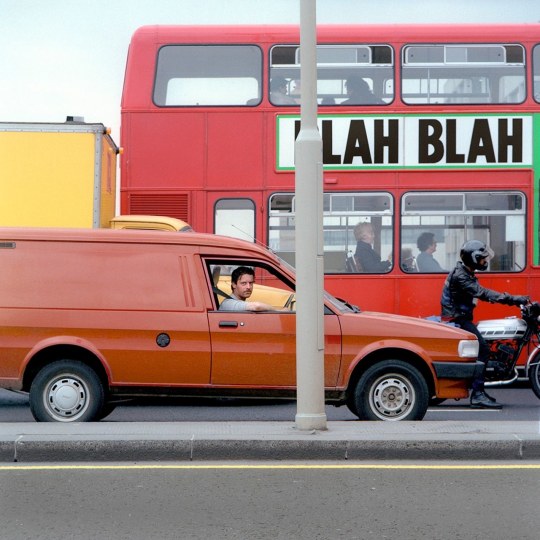
Chris Dorley-Brown

Franck Bohbot

Vlad Tretiak
Mileage May Vary is entirely shot on film, to reflect on the anachronistic and hauntological aspects of the subjects, but mostly due to my own personal choices of image creation. The analogue workflow, as well as the equipment, is much more enjoyable to me. Colour film shall be utilised for this project to document and detail the reality of the subjects, such as Kodak Ektar 100, Kodak Pro Image 100, Kodak Portra 400 as well as expired film stock. These negatives shall be scanned at a high DPI to allow for larger prints if necessary.
For Free Range, there shall be a nicely presented coffee table style photobook. Depending with who I choose to self publish the book with, this can cost from around £40 for a 30cm x 30cm hardback layflat with 26 pages from Bob Books. However, they do offer a large landscape books (38cm x 29cm) from £55 or a large portrait (28cm x 35cm) for £51. This would mean a substantial amount of money would need to be spent on film, photo book and prints. This will also need a good amount of time to get enough images together, edit them down and prepare them for print.
Shooting commences immediately after the end of PHOT301, hopefully shooting at least one roll of film per week up until April/May, when editing the selection of images down to create the photo book. Also, I envisage a handful of large scale prints, up to at least A0 from the Digital Print Bureau or from a third party printer. All of these deliverables will culminate in a professionally curated and informed project documenting the vehicles that escaped the 2009 VSS.
Bibliography
Behance, (2019). A Small Town in Siberia II. Behance. [Online]. Available at https://www.behance.net/gallery/81633539/A-Small-Town-in-Siberia-II. [Accessed on 01/12/2019]
Franck Bohbot’s Portfolio. (2019). Franck Bohbot’s Portfolio - Parked cars | 2013-2015. [online] Available at:https://www.franckbohbot.com/6914744-parked-cars#e-44. [Accessed on 1/12/2019]
Rosenberg, D., (2015). Being Stuck in Traffic Never Looked So Good. Slate. [Online]. Available at https://slate.com/culture/2015/06/chris-dorley-brown-drivers-in-the-1980s-is-a-look-back-at-london-car-culture-photos.html. [Accessed on 14/01/2020]
1 note
·
View note
Photo
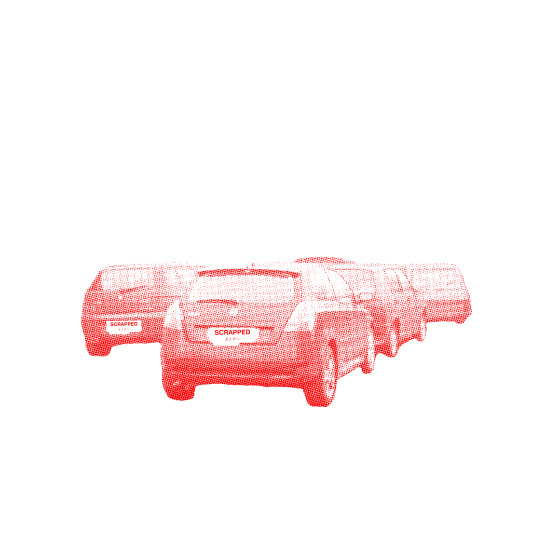
PHOT301 - Mileage May Vary - An Evaluation
The first portion of this project has gone already? Those people weren’t lying when they said it’ll go fast once third year comes around. And this evaluation marks the end of PHOT301, which is the early stages of the FMP, featuring all of the research and planning of ones project. Although this is only the beginning for what I finally titled ‘Mileage May Vary’. This project is the culmination of a majority of previous works all the way back to my access course, which started in 2016. The seeds of MMV were planted all throughout my tenure at university, with elements from PHOT103, 104 and 201.
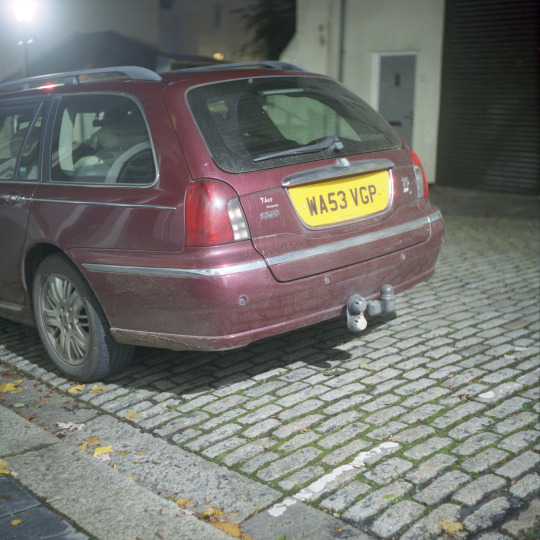
Rover 75 - Mamiya 6 IV - Cinestill 800T
PHOT202 is where my work took a turnaround. That whole project was a massive mistake: start to finish. It had the right intentions from the get go, and was meant to let off where Alienated Spaces left off. However, I felt alienated about a project about alienation as I was trying to convey something that had dwindled over time. This lead to me leaving anything contextual behind and focusing purely on taking images for the sake of images. It was during this time of making images without any substance, I thought of a project that documented cars that managed to escape the 2009 Vehicle Scrappage Scheme. Annoyingly, this thought came to me when I was a good way through PHOT202 and wasn’t able to go through with changing an entire project, but I wanted to keep hold of it for a summer project, which then turned into my third year work.
The summer time isn’t a conducive time of year for my to be working, as I find the harsh sun and long days uninspiring and the weather is always too hot. That may come across as whiny, but it is just how I feel about the summer. I managed to get one measly shoot in before university started again in September, yet it was interesting to see where my head was at, in terms of composition and creating images. This managed to lead me into a practice that as mostly self lead, but also included an amount of research to back up what I am doing. Although, I piqued up my reading on hauntology, and came to the realisation that it has been omnipresent without my knowledge since the very early days of the degree. Hauntology is something that took me a long time to get my head around, as the first interaction of it was convoluted. However, with much more reading on the internet, and Mark Fisher’s writing made it a lot easier to grasp the spectral haunting of our society. Fisher has always been an accessible writer to me, and makes somewhat complex theories by making them link into something contemporary, which I find a lot easier to digest. I found Derrida’s original text about hauntology was difficult to take in and only made me hate it. Fisher does a good job in making some palatable without dumbing it down.
The other aspect that informed my practice was governmental data about the VSS. Thankfully in 2014, the government released the numbers from the scheme, which detailed how many vehicles were scrapped between 2009/2010. However, there are some detailed discrepancies with the data as it was all taken from different sources, and those sources were each and every dealership that received candidates for scrapping. Despite this, it was interesting to see the ‘reality’ of the numbers regarding the vehicle scrapping. Perhaps in the final stages of MMV, I should look at the highest number of scrapped cars and document them.
Shooting the project was potentially the easiest experience as of yet. The process of finding subjects was mainly walking the streets of towns and cities. There is no way to gauge what one is going to find as its impossible to know what cars are on what street, with the only way to know is to find out. Finding the right subject was a form of trial and error, with a lot of the cars mainly on the streets now won’t be affected by the VSS as they didn’t exist. Some models did however, but the date on the registration plate would place it after the scheme. The technical aspect was no problem either, as I am now fully proficient and reliant on shooting film for personal projects.
There also wasn’t many issues regarding shooting apart from the exposure issues, which was down to me, and the same roll being slightly damaged by the processing provider. These can be overcome by making sure the equipment is in place, and changing where I process my film for colour. Whilst that may cost slightly more and take longer, its the peace of mind knowing that it probably won’t be damaged by a rushed process.
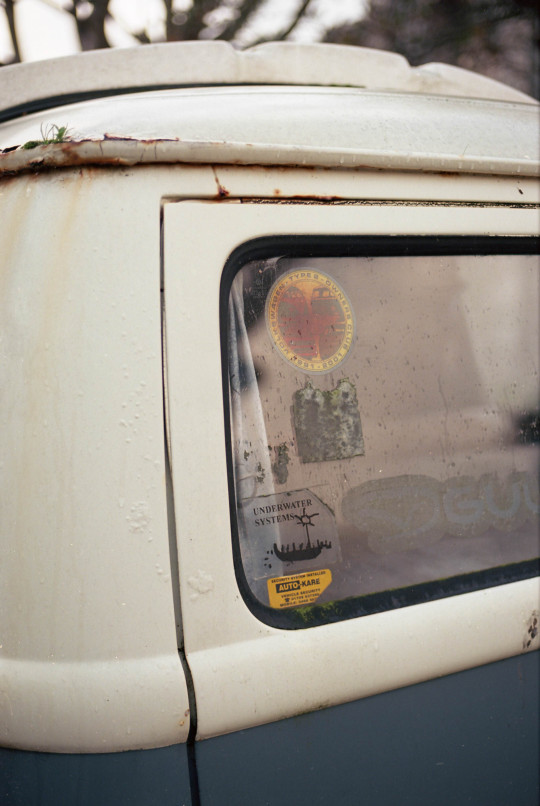
Volkswagen Type 2 - Canon EOS-1 - 50mm F1.8 STM - Kodak Ektar 100
Taking the photos was a breeze, as I knew what I was looking for and taking. Although, what is included in the photographs has varied over the course of the project. It started with composing the majority of the vehicle in frame, but after talking to Jack Latham, it seemed like a good idea to focus more on the details of the car. I was including things like scrapes and dents, as this shows that it has been used and knocked over the years. But, I was featuring these points whilst the vehicle was mainly in view. I have mixed these together instead of limiting myself to one kind of composition.
One thing I would improve upon is shooting more medium format images for the higher fidelity of negative. I only shot one roll of medium format during these stages of the project, and this was the roll of which I had a shutter speed issue and the roll of soiled by MyPhoto. One thing I would like to experiment with the Cinestill CS41 kit, which allows one to develop colour film at home, with the same process as B&W. This makes it a lot easier to develop colour, as it is a finicky process with tight tolerances with temperature. I also decided to disregard shooting black and white, as I wanted to document the pragmatism and realism of the vehicles.

The photo book is something that I feel my work lends itself to, as it can contain a narrative bundled together in a handheld package. At this stage, I didn’t want to produce a self published book as it is still the early stages of MMV. However, I did want to make something that contained these elements, but had a level of experimentation to it. This is where the ‘zine’ comes into fruition; although I am not sure what to call it, as its a mix of a photo book and work in progress documentation of what I want to create further down the line. I made the online/PDF version on Canva, as it is a free and powerful tool to create graphics and documents. Once I knew what images I wanted and how to display them, it was rather easy to create. The cover was the most challenging aspect to this, as I knew I didn’t want to just have a photograph on the cover, and I wanted to resurrect my graphic design work. For this, I utilised one of my images and editing it with GIMP, a free alternative to Photoshop. The cover contains semiotics to the entire project: cars are the sole image on the cover which reflects on the project’s subject, which is coloured red to signal the Labour government’s scheme and the bitmap effect was to give the illusion of newspaper articles about the scheme/news. This is a style that I would like to go back to and hopefully keep using for the next portion of the FMP.
Being informed and influenced is something that I written about being somewhat difficult for me. Whilst I do digest photography on a regular basis, only some of that actually makes an impression. I can appreciate a nice photograph, but it rarely gets my creative juices flowing. Although once in a blue moon I will stumble across a practitioner that just gets me. Once of those is the little known Vlad Tretiak; a Russian based photographer with a partial social media following. His work manages to intrigue me in a technical aspect as he shoots medium format at night time, as well as the subject themselves. I have always had a fascinating with anything Russian and Soviet related, and this manages to meld in my love for cars. Chris Dorley-Brown was tuned into me by Jack Latham, and Dorley-Brown’s work focused on the portraits of motorists stuck in traffic during the summer of 1987 in East London. I rarely enjoy photographs containing people, but it made me think that my work as portraits of the cars themselves. I also was inspired by Franck Bohbot, who I looked at during PHOT104′s Economy project. These practitioners, as well as the contextual research of hauntology has spearheaded me into a well informed project, which after PHOT202 was much needed.
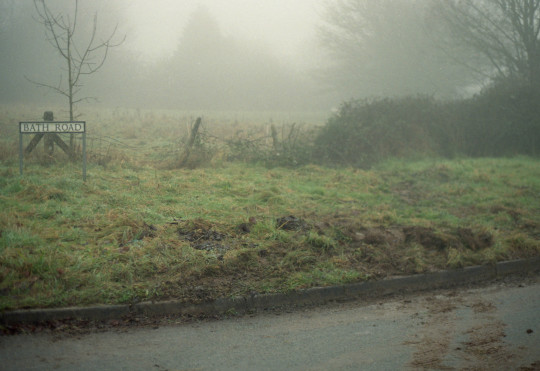
Citroen Berlingo Aftermath - Canon EOS-1 - 50mm F1.8 STM - Kodak Colour Plus 200
Where does this lead me for the final stage of the FMP? With all of the now previous work, I feel as if I have a good project on my hands and that I can take it far. It feels as if I am finally undertaking a project that I am actually enjoying to shoot to produce, in addition to not feeling like it’s died as soon as it has been handed in like previous projects. The premise of this project was on my mind for a while and I am happy that I can finally undertake it, and take it into the future to wherever it will take me. What I have produced is something that I am proud to have my name to, and it has garnered some good feedback and constructive criticisms. The work flow shall continue after PHOT301, and any film started before, and hasn’t been finished before the deadline shall be used for the second portion of the FMP. With the continuing stages of MMV, I plan to still use the compositions of full car and close up detailed shots, but I would like to incorporate the numbers/statistics of the cars that were scrapped - possibly even photographing a selection of the most scrapped vehicles from the government spreadsheet. The prints will also progress, as I plan to print at least A0 for Free Range and accompany them with a layflat ‘coffee table’ style book, detailing an edited down selection of all vehicles photographed during the project. Technically, I would like to utilise more medium format and find a more uniform visual aesthetic in regards to tones. This would mean possibly shooting one type of film and edit them accordingly. Although I would like to use some expired film to add to the hauntology of the photograph, as well as using a film stock that co-exists with potential vehicles in frame. If multiple stocks are used, I shall to the best of my ability edit them so they are visually similar with little difference between them.
I feel that this has been the most enjoyable project to date, as it has been totally up to me with what I do, instead of interpreting a brief and making my work fit it some how. With this, I have been totally free to create what I want to create in a professional and informed manner. I am looking forward to seeing what the future brings for this project.
0 notes
Photo

PHOT301 - Mileage May Vary - Interim Shoot 15/1/2020
A new year starts, and the work continues. However, by this time, shooting for PHOT301 had finished and the workflow mainly centred on making sure the blog is in check and tying up any loose ends. On a rainy Wednesday night, Aaron invited me and Harriet to check out Faraday Mill; an area that I have always wanted to explore but never got around to. I loaded up my Canon EOS-1 with some Cinestill 800T and got ready for a shoot...but the weather had other ideas.
And it rained all night. As the night was washed away, I chose to keep the EOS-1 safe for the time being and left it at home, but went out anyway to treat it as a recce of the location. I have driven past Faraday Mill for years and always wanted to see it at night. I am not sure how I haven’t been there, as I am fairly familar with wondering around Cattedown. This area was a goldmine of intriguing vehicles, cars broken for parts or left in disrepair. Thankfully, I had my phone to get some reference images. One of them that I captured was this little yellow Vauxhall Rascal.

The Vauxhall Rascal, which used to be called the Bedford Rascal, which is based on the Suzuki Super Carry is a Japanese ‘Kei’ truck or microvan. Kei cars in Japan are a category of automobile which classes them as lightweight street legal vehicles. They are usually regulated to 660cc engines, with other specific power outputs, weights and dimensions. However, the British derivative has a powerful 970cc four cylinder, which catapults the Rascal to a neck breaking 60mph. Despite their diminutive size, they were fairly handy small vans which can carry a surprising amount of weight for something about the same size as a pressure cooker.
These hold a special place in my memory, as it was one of the vehicle that my father had for work, oddly enough, when I was very young, possibly around 4 years old. I have a distinct memory of it being very cramped, noisy and dangerous, to the point that we almost tipped it over on a sharp corner, somewhere near Selsdon. Thankfully, this example hasn’t totally turned into a pile of rust and is still taxed and MOT’d! If anything, this project makes me thankful that some people still have relics of the past on the road. However, in reality they aren’t all too old, as the Rascal is only around 30 years old, and they’re diminishing in numbers and considered either defunct or a cult classic. It still amazes me that something that was only built 30, or even 10 years ago is now considered total junk and needs to be got rid of.

We did explore more of Faraday Mill, but I forgot to use my phone to get any more images on that day. This was a shame as there were a few cars left on a road which looked abandoned, but weren’t. I know this because I went back with my EOS-1 the next night when it was dry and shot the majority of the roll, and found some better subjects in return - this is the fateful roll of Cinestill 800T which I have mentioned in previous posts. This will be continued after PHOT301, and shall lead onto PHOT303, and of course will be scanned and uploaded once they’re ready, fairly soon.
Its certainly a shame that I didn’t have a camera with me at the time, but was also beneficial as I was able to scope out the area before partially shooting there - it was great to find some automotive relics, also. I am looking forward to seeing what is on that roll, and what will take the places of the final 12 or so shots. It felt a shame to not include these and not inform that I had returned with a camera to the area, but at a 24 hour later date.
0 notes
Photo

PHOT301 - Mileage May Vary - Research and Influences
Influence is a funny thing. Looking at other’s work has always seemed odd to me as it comes across as you’re ingesting what they create, and then recreating it. To me, it seems somewhat disingenuous to take someone else’s work and make it your own, as it doesn’t seem entirely conducive to create a body of work. Perhaps there’s a disconnect between looking at work, and being influenced by it. Because of this, I don’t tend to look at other photographers work nowadays. The ways that I ingest photographers is usually online, with social media applications - but sometimes I stumble across words of wisdom with passing visiting practitioners such as Nicholas J.R White or Jack Latham. As for social media, its people such as Vlad Tretiak. And past projects such Chris Dorley-Brown’s “Driver’s in the 1980′s”.
How do I get inspired? This, is the million dollar question. Inspiration has been always a stumbling block when it comes to my work: I don’t like looking at other people’s work and taking it and I rarely find work that truly resonates with me. I have always found it easier to shoot more often and see where my eye takes me. One could say that my eye is influenced by what I have ingested, and that could potentially be the case. The other thing that initially inspires me is the contextuality of my practice, which is usually philosophically based with some political undertones. My previous work played a lot on my own experiences living in a modern capitalist society - PHOT201 featured a lot of my own personal feelings on alienation/estrangement, and PHOT102 used my interests of Brutalism. In terms of PHOT301, this is spearheaded by the intrigue of the system that we live in, the 2008 Financial Crisis and the then Labour Government’s 2009 Scrappage Scheme. As well as this, there is the personal appreciation for the everyday vehicle. Mentioned in the post in the first shoot, I talk about how I grew to appreciate the car that the layman use on a day-to-day basis. Cars of a certain age were purged once the Labour Government unveiled the scheme to rid the roads of ageing vehicles, replacing them with newer, safer and more environmentally friendly options.
This scheme was set after the 2008 financial crisis, where banks were allowed to trade through a deregulated system, demanding mortgage schemes which they couldn’t necessarily pay back. This lead to banks like Northern Rock collapsing, which returned to private ownership, but dissolved in 2012. The global financial crisis of 2008 led to a mass recession across the western world, causing the most significant financial crisis since the great depression. In the 2009 budget, the Labour government unveiled the VSS as an incentive for motorists to trade their old car, get a discount, and get a brand new car which offers greater safety, reliability and environmentalism. Governmental information regarding the scheme is easily accessible on the internet, and can be see - https://www.gov.uk/government/uploads/system/uploads/attachment_data/file/357672/bis-foi-2014-20775-scrapped-vehicles-supporting-data.csv/preview .
With this link, one is able to download an Excel file which details all of the vehicles scrapped in 2009. This covers everyday cars of the day like the Rover 214 (of which 2045 were scrapped), as well as odd manufacturers such as Lada’s Riva, where 7 were scrapped. In total, 392227 cars were scrapped in total, according to the spreadsheet in 2009. The document can be seen here - https://drive.google.com/open?id=1azLGX99mmsL79kbA8qnUuV_C8_k3fI--

Meaning, the Government managed to get rid of a number not too far off of half a million undesirable vehicles from the scheme alone. That being said, there are some discrepancies within the document, such as potential duplicates and spelling errors which could hamper the end result.

Thankfully, the ever helpful Government have released a document with the results which states that there is some variability, as the information was collected by the manufactures instead of the Government itself for the VSS (Vehicle Scrappage Scheme). These numbers are fascinating to me - browsing the document also brought up some interesting results. A lot of the manufacturers that are/were stationed in the U.K, such as Ford, Nissan, Peugeot and Vauxhall recorded higher numbers compared to manufacturers such as Mercedes or Volvo for example. This means, there is some potential correlation between vehicle manufacturer location and scrappage numbers, as well as the type of manufacturer that’s marketed. Higher market vehicles, such as Mercedes again saw lower numbers in general, compared to a more consumer based manufacturer such as Toyota. Obviously, this would make sense are Toyota is more of an accessible option compared to Mercedes.
Top 5 Scrapped cars from 2009/2010
Ford Fiesta - 13622
Nissan Micra - 11808
Vauxhall Corsa - 10453
Volkswagen Polo - 8432
Vauxhall Astra - 8066
(info provided with the VSS Spreadsheet linked above)
This is intrinsically fascinating to me, as it puts into perspective the number of vehicles that were rid within the period of the scheme. Despite the high number of scrapped cars, many of these models still roam our streets. There is a great website titled ‘https://www.howmanyleft.co.uk/’, which collates Governmental data on cars that are left on our roads. The website can be used to search models of cars that are still being used today, which details cars that are being used on the road, as well as cars that have been SORN. For example, we saw that 2045 Rover 214s were scrapped in 2009. Today, there are only 155 left on the road, with 189 SORN (not on the road). The graph the website offers shows the rapid decline in 2009, correlating with the VSS. This can also be used to see the gradual decline of the vehicle’s usability, whether that’s due to owners discarding it or replacing it.

This information spearheads the project, mostly in it’s entirety. This projects sets to document what’s left behind from the VSS, as well as the vehicles themselves. Each one is different despite it being made identical in the factory with robots and humans. Each and every car has been used differently by different people, and this shows different ways in which it has been worn and battle torn. These can take the form of scrapes, dents and missing pieces of trim - which can sometimes be enough for one to scrap their car. Despite the scheme being scrapped in itself in 2010, VSSs are still being employed by manufacturers and website on the internet. This means that these cars aren’t all that safe after all. They might have missed the initial barrage of time, and the Government’s scheme, but at any moment they could be still given into the dealership and discarded, being recycled into a fancy washing machine or a bean tin. Manufacturers such as Citroen and Vauxhall still offer such schemes, with money-off incentives on new models, as well as a scheme in London set by Sadiq Khan, with vehicles such as mini vans and mopeds to be scrapped to reduce carbon emissions in London, with an ultra low emission zone in London by October 2021 (TfL, 2019).
There is also a somewhat philosophical aspect to this body of work, also. Hauntology has risen in popularity within the last decade, with Mark Fisher potentially reviving it into the focus of conversation with his easily accessible writing. At first, I found Derrida’s original explanations absolutely horrid to understand. His writing (to me, at least) was often confusing and convoluted. Thankfully, Fisher’s writing in Ghosts of my Life and What is Hauntology offer realistic and easily understandable explanations on what Hauntology really is, and how it’s applicable to our contemporary zeitgeist. It can really be distilled into ‘a time out of joint’ (p.21. Fisher. M. Ghosts of My Life). Hauntology is really the philosophy of the past haunting the present. Derrida links Communism being a spectre on western Capitalism. This, can be applied to almost anything within popular culture, in addition our world now. Fisher also mentions our futures, due to our mixture of past melding with our current times. Things have been increasing harder to see what the future really is, as our times become more anachronistic. This all plays into my work, in terms of subject and what it has been taken on. The cars themselves are inherently anachronistic, as they belong from a different time period. And, the images themselves have been taken on cameras that should, in essence, be extinct - hence digital photography has taken the spotlight in contemporary image making.
Although, film photography certainly is a spectre hanging over digital photographer, and offers up a form of spectral nature of itself. Yet, there is still a place and a market for analogue photography, despite companies either discontinuing their stock or raising prices. The rationale of shooting film is purely a personal choice. It isn’t because I think it’s better than digital, it’s because I enjoy the tactility of the equipment, and the process of scanning in a physical photograph. There are so many more nuances and variables that can’t be corrected once it has been taken, and can only really be corrected once it has been digitised with a scanner. It may even defeat the point when an analogue image is digitised, as the scanner is interpreting the tones and colours of the film with its processing and software - scanning with different scanners can vary everything about the film. I found this out when I bought my own Canoscan 9000F MKii in first year, and there is a massive quality difference between the Canoscan and my favourite scanner: the Epson V850 Pro. This, of course is due to the large price difference and aim towards the demographic. The Canoscan is aimed purely at the enthusiast who needs a scanner, and might potentially need to scan the odd roll of film. The Epson is of course aimed more towards the professional, with the increase in scan quality and scanning options. With this, there are quality differences, with the Epson scanning a lot flatter, with increased dynamic range, compared to the Canoscan’s odd colour cast and contrast increase.
Visual Inspiration
Vlad Tretiak - A Small Town in Siberia II
As mentioned before, I find visual inspiration often hard to come across, with a feeling of nihilism towards looking at photographers of the past. Many copy established photographers which to me, renders the image useless as you’re just recycling someone else’s project or aesthetic. I do feel that it’s good to look at photographers and take notes from what they create, but not totally rip off what they have already done. The biggest inspiration for my work at the moment is a little known photographer based in Russia, called Vlad Tretiak. He is a Russian based photographer and graphic designer. His work centres around parked cars in the dusk hours, with Tretiak often utilising street lights to enhance the aesthetic of the image. The cars he documents aren't brand new offerings from the automotive conglomerates; they're often bruised Ladas and Japanese obscurities, as well as documenting the spaces that these cars occupy.
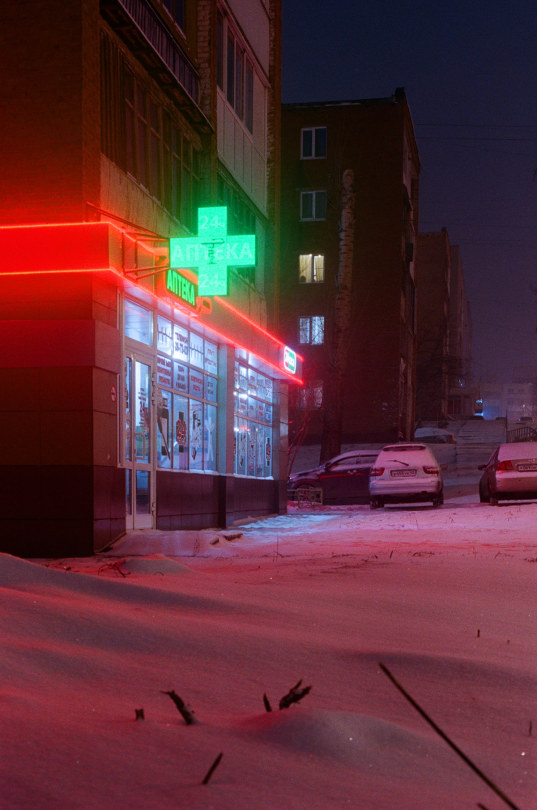
The project doesn't just focus on the cars, but also the small town in Siberia, which is Kemerovo - a town closer to China than Moscow. The landscape is often ridden with Siberian snow and the town's neon lights creates an almost vaporwave feel to his work. They're also incredibly cinematic, with an almost tangible look and feel. Tretiak shoots mainly on a Pentacon Six or a Mamiya C33, often with expired film, such as using Kodak Aerocolour III; which has long since been expired. This gives Tretiak's work a hauntological aspect, as he is shooting scenes with film that shouldn't exist in this time (theoretically). With this, it creates a haunted present, as it's presented on a format that is from another time period - unlike shooting fresh film which has been produced in the contemporary sense, but uses the same formula.
All of these aspects makes Tretiak a key piece of research for Mileage May Vary, as it shares a lot of the same themes and aspects as mine. The biggest thing I can learn from A Small Town in Siberia II, is the use of lighting. My previous analogue night photography attempt was lacklustre purely due to the light, as well as not exposing the film for long enough to get some of the shadow detail. I do plan on shooting on some expired film for my project, and as older film usually needs longer to expose, this will lengthen the night exposures exponentially. Yet, Tretiak manages to keep these images looking crisp, clean and clinical. The images are incredibly sharp and features such a deep tonality. There aren’t many practitioners that when I look upon their work, I think to myself that this is what I want to be striving for. a lot of the time, I blankly gaze at work and nothing works for me, but there is something about how Tretiak manages to capture the scene, isolate the subject and use natural, and artificial light to his advantage. The scenes are also so mundane to the layman, as they are just Ladas being photographed in their natural environment in Russia.
This also has another link to Hauntology, as these cars are haunted by the spectre of Communism itself. They were born from the CCCP, lived through the state and now survive in a Capitalist Russia, and then they are documented on a process which has been superseded by a digital process. They’re scenes haunted by Communism, taken by a haunted process. It makes one think how omnipresent Hauntology really is, and this is the reality that we live in. It also makes me think that I have always had links to the CCCP and Hauntology without me really knowing. I have managed to document Brutalist structures and things of the past, but in the present; but its only now that I am able to see what I have been doing and it’s contexts.
Below, is a number of Tretiak’s images from that project which I really enjoy.

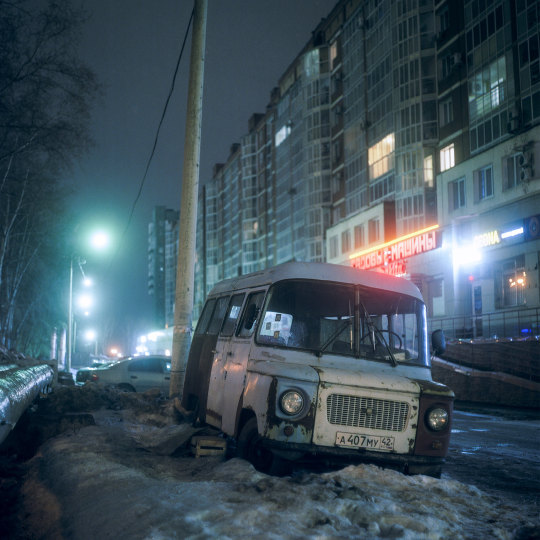


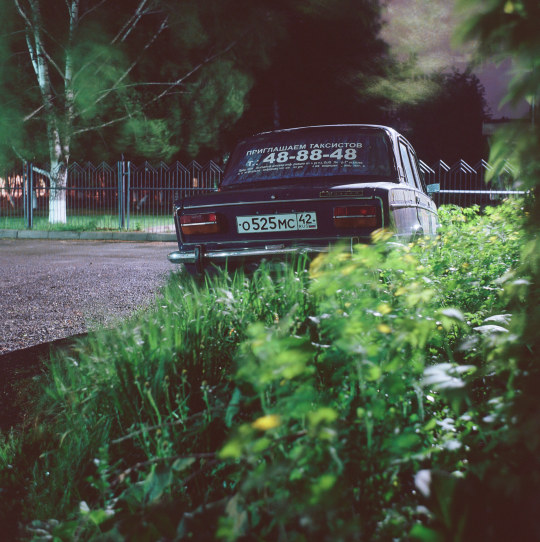
Chris Dorley - Brown - Drivers in the 1980′s
I came across Dorley-Brown’s work due to Jack Latham recommending his project to me to look at for MMV. The project in question is Drivers in the 1980′s; a documentation of drivers stuck in East London traffic jams in the summer months during the 80′s. Dorley-Brown initially wanted to document the privatisation of Rolls Royce, but instead chose to photograph the faces of the traffic jams of Thatcher’s Britain. For me, its a very humanising project to look upon, and feels slightly odd enjoying a body of work which features actual people. I often feel slightly alienated to look at work with people in them, as I don’t really have any or no connection to the subject. Yet, a lot of the images within this project feel very candid and Cartier-Bresson-esque in terms of their decisive moment feel. That being said, some of the subjects have noticed Dorley-Brown and posed for the camera, knowing they will be photographed and changed their pose ala-Barthes.
Speaking of Barthes, Dorley-Brown’s work feature both studium and punctum. The studium is the subject, and something about it that has jumped out to Dorley-Brown, and the punctum is the end result of that studium. And the end result is rather aesthetically pleasing for what is essentially a portrait of the urban environment.


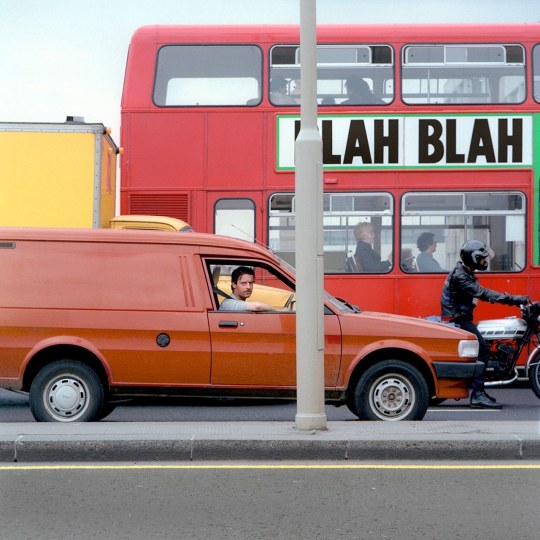
There is an immediate aesthetic to these images that just shout out 1980′s, purely because of the tones and colours. There is something about these aspects of which I enjoy, and I am not entirely sure why that is. Perhaps its linked to nostalgia, as these was only taken 10 years before I was a small child, and I can remember seeing photographs in a similar style to these. Either that, or its the cars included in the photographs, which I used to see when I was younger and feel nostalgic about seeing; or that I have fallen for the Capitalist ploy to sell me nostalgia of the 1980′s despite never actually experiencing it first hand. There must be something with the emulsions used at the times, causing these bold, yet washed out colours. All of these photographs were taken with either a Rolleiflex 3.5 or a Mamiya C33 (as did Tretiak in ASTiSii). In addition, eight rolls of film were shot in a space of six hours, with a total of 162 photographs. Dorley-Brown is noted in saying about shooting the project:
“They are both waist-level finders so that put me at driver level and helped me be a bit more invisible,” he wrote via email. “People are never sure with those viewfinders whether you are looking at them or not so it gives you some space to work without appearing too obtrusive.”
This gives one insight in the creation of the work, and the use of a TLR camera. They are something that I really want to love, but hate using. Looking down at the viewfinder always feels very unnatural to me, and the inverted movements always throw me off. However, this hasn’t stopped me looking at purchasing a Mamiya C33 or equivalent down the line. Perhaps I will learn to love TLRs, just like I learned to love square format images, and seeing as the C33 is 6x6, its another hurdle to overcome.
Franck Bohbot - Parked Cars
Bohbot is a French born photographer and film maker based in New York. His images offer a cinematic and meticulous approach to image making. They also offer a certain atmosphere that juxtaposes the reality of the day to day. I will be focusing on Bohbot’s ‘Parked Cars’ project. I used Bohbot during the Economy Exhibition, as he used a very similar composition style to what I was already doing. I found the typography of his images very Becher-esque and visually intriguing, as its interesting to see a lot of cars presented like this.

Parked car, Parkslope #1 Brooklyn, NY, 2013
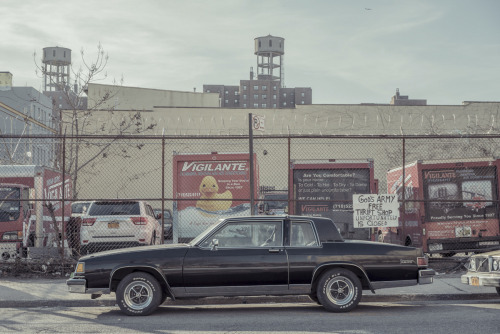
Parked car, Gowanus #5, Brooklyn, NY, 2014
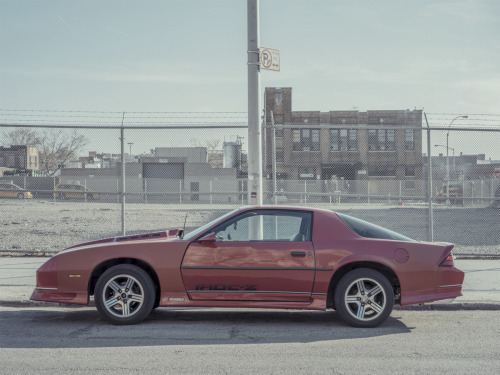
Parked Car, Gowanus #6, Brooklyn
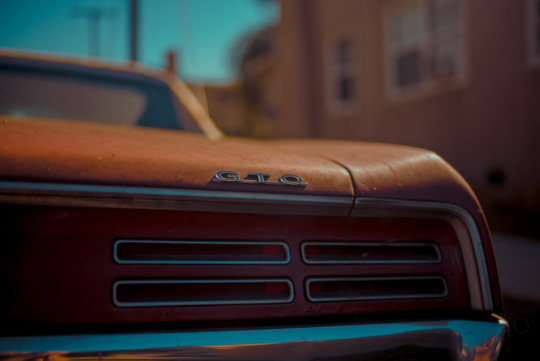
Untitled
Bohbot offers an interesting take on a typographic style of automotive photography. It manages to capture the vehicle, as well as the surrounding space around it. They often tell us things about the area as well, just like the state of the economy and the grade of social status of the occupants. The photographs also tell us what kind of life the vehicles have lead. Just like the Camaro Iroc-Z above, it has discoloured/faded panels. This could mean they have been replaced because its had a collision, or they have just faded over time. Red paint has a habit of doing that as the wavelengths absorb more light compared to other colours, and the UV light degrades the paint faster (oh my previous life as a mechanic and body repairer). This can also be seen on the Caprice Classic at the top, as that has heavily faded and also started to rust around the wheel arches. These elements especially reflect on what I am doing, and focusing on the cars that have aged and seen some years of use. These scrapes and scars can tell a story of what the vehicle has gone through, and shows that its just a mode of transport that someone uses.
Since looking at Bohbot’s work in first year, it has been updated with more detailed and less typographic images. An example is of the Pontiac GTO’s rear lights/badge. Just like my current work, it incorporates a more detailed look at the wear and tear of the vehicle, in addition to using a shallow DOF to isolate the subject.
A Coda
Being inspired and influenced by practitioners is something I find that’s hot anc cold. Quite often, I rarely find photographers that I really get and understand. It seems all too often I blankly stare at ones work and it doesn’t do a thing for me, and I tend to find it easier to just go out and shoot, without any prior research to see where my creative mind is at. Although, I do find that sometimes, one does need to ingest other’s work and get some insight into how they create that work - whether that is due to the camera or film they have used, or the way that they have composed and taken the photograph. Of course, this can be a valuable asset to the photographer to gain insight into how to make a photograph just that little bit better, or something to avoid if they haven’t executed it properly. With Tretiak, Dorley-Brown and Bohbot, they have certainly informed and influenced how I make my work. I enjoy all of their images, and find it fascinating how they actually make their work, as well as the context within them. Yet, these projects seem different, and oh so similar at the same time. Tretiak is documenting the vehicles that lay dormant where he resides, and Dorley-Brown documents similarly dormant cars, but in the hustle and bustle of the nation’s capital. Finally, Bohbot documents the dormant and parked cars in Brooklyn, where the social and economic background is vastly different to the Manhattan setting that most people think of when New York is mentioned. All of these play a key roll in my work, and are useful to further my practice.
I also find its key to have some contextual backing to the work. All the way back in PHOT202, I ditched anything contextual and focused on the aesthetic of the photograph. This wasn’t a great idea, as it totally sabotaged my grades and was harshly scrutinised - deservedly so. Just like a broken record, I repeat to say that I hated PHOT202 and it’s outcome. Now, I am creating work that I am proud to be attributed to and willing to progress with. MMV is a project that feels that it will last me a long time, as previous projects felt as if they died as soon as they were handed in and never felt as personal as they were portrayed to be. But somehow, MMV feels as if I can keep this project going, even past university is over for me. Perhaps this is because its something that I want to be creating, rather than interpreting a brief and making something fit with brute force.
Bibliography
Behance, (2019). A Small Town in Siberia II. Behance. [Online]. Available at https://www.behance.net/gallery/81633539/A-Small-Town-in-Siberia-II. [Accessed on 01/12/2019]
Franck Bohbot’s Portfolio. (2019). Franck Bohbot’s Portfolio - Parked cars | 2013-2015. [online] Available at: http://www.franckbohbot.com/parked-cars [Accessed 1 Dec. 2019].
Franck Bohbot’s Portfolio. (2019). Franck Bohbot’s Portfolio - Parked cars | 2013-2015. [online] Available at: http://www.franckbohbot.com/parked-cars#e-5 [Accessed 1 Dec. 2019].
Franck Bohbot’s Portfolio. (2019). Franck Bohbot’s Portfolio - Parked cars | 2013-2015. [online] Available at: http://www.franckbohbot.com/parked-cars#e-35 [Accessed 1 Dec. 2019].
Franck Bohbot’s Portfolio. (2019). Franck Bohbot’s Portfolio - Parked cars | 2013-2015. [online] Available at: http://www.franckbohbot.com/parked-cars#e-8 [Accessed 1 Dec. 2019].
Franck Bohbot’s Portfolio. (2019). Franck Bohbot’s Portfolio - Parked cars | 2013-2015. [online] Available at: https://www.franckbohbot.com/6914744-parked-cars#e-24 [Accessed 1 Dec. 2019]
Rosenberg, D., (2015). Being Stuck in Traffic Never Looked So Good. Slate. [Online]. Available at https://slate.com/culture/2015/06/chris-dorley-brown-drivers-in-the-1980s-is-a-look-back-at-london-car-culture-photos.html. [Accessed on 14/01/2020]
Fisher, M., (2014). Ghosts of My Life: Writings on Depression, Hauntology and Lost Futures. John Hunt Publishing (p.21.)
Jones, M., (2016). Angry drivers stuck in London traffic during the Eighties. British GQ. [Online]. Available at https://www.gq-magazine.co.uk/article/drivers-1980s-book-london-hoxton-press. [Accessed on 14/01/2020]
Transport for London, and Matters, E. J., (no date). ULEZ Car and motorcycle scrappage scheme. [Online]. Available at https://tfl.gov.uk/modes/driving/ultra-low-emission-zone/car-and-motorcycle-scrappage-scheme. [Accessed on 08/01/2020]
1 note
·
View note
Photo
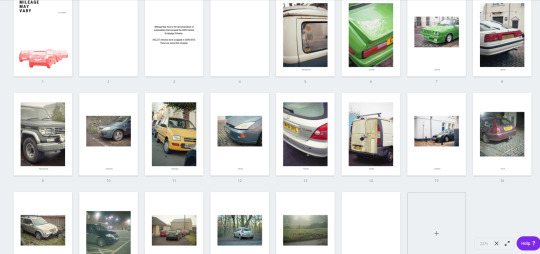
PHOT301 - Mileage May Vary - Work in Progress Zine & Experimental Journal Ideas
The zine is something that I had mentioned in the formative assessment for PHOT301. I wanted to make this because I was curious to see how this body of work came together in a book/zine/magazine format. One of the end results that I want to have for the FMP is a coffee table style book that can be viewed at Free Range, and contain a multitude of images from this project that clearly shows what my project is about. For this, I need to run a few tests to figure out what I should be creating, and how to make it.
For this, I decided to create a zine style of booklet, displaying images from this project that I particularly enjoy. The rationale for the selection process was selecting the cars that had an air of intrigue within them, whether that be with damage to the vehicle, or that the vehicle is particularly rare to see. I then decided to lay out the zine with the cars in chronological order, going from oldest to newest. However, it finishes with the aftermath of the crash that happened very close to where I was staying during Christmas, but sadly missing its departure only by an hour or so.
The front cover was also something that I was contemplating for a while, and was the most worrisome part of the whole experience. I knew how I wanted to display my images, and how which ones I wanted, but was very unsure on what would represent the front cover. I have always wanted to rejuvenate my graphic design style of work that I undertook during my Access Course and PHOT103.
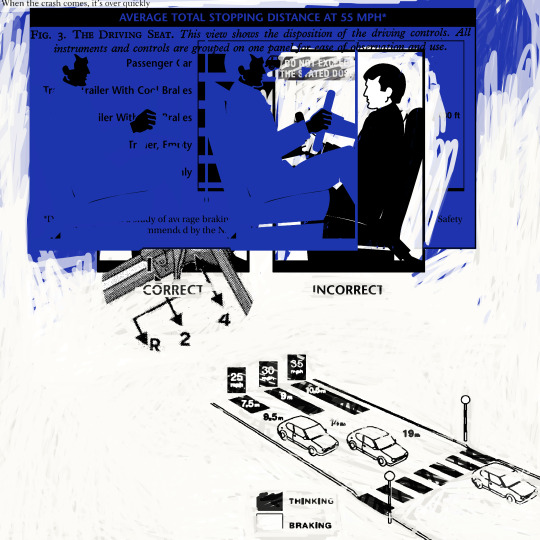
This is my favourite example from Exploded Image, all the way back in first year. This project was mainly a spin on our very alienating, fast paced and transport centric world. It was heavily influenced by Stanley Donwood’s artwork for the ever inspiring 1997 OK Computer by Radiohead. This is a style I have wanted to revive and to place elements of it into my current work - I also find it interesting how a lot of the earlier aspects of my degree are surfacing up again, which is a welcome change to the fairly similar work that was undertaken during year two.
I had an idea of what I wanted to create, but unsure about how undertake it. The graphic elements had to be a part of it to make somewhat of a statement with the front cover. I don’t necessarily want it to be a straight photograph, as it only really tells you about the photograph, rather than the project. Subtle hints to what the project is about, seems like a good aim for me.
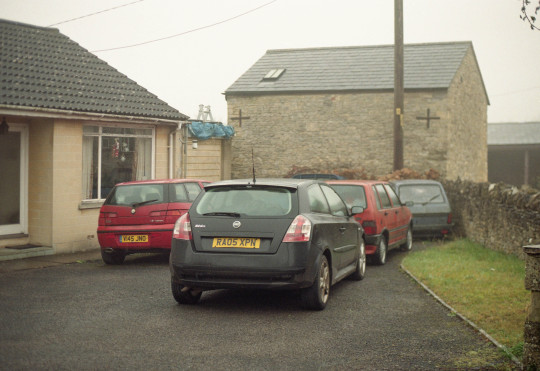
Before

After
Above, is what I had created. I chose to use the cluster of parked Fiats and Alfa Romeo as it featured a good amount of cars, rather than a singular vehicle in the image. I opened it up into GIMP and erased away the surroundings, only keeping the parked cars. The photograph was then desaturated and then coloured red in a gradient map style, with an added a bitmap style of manipulation. This was the emulate the newspaper print styling of new reports of the scheme, and the red colouring represents the Labour government that brought the scheme to fruition.
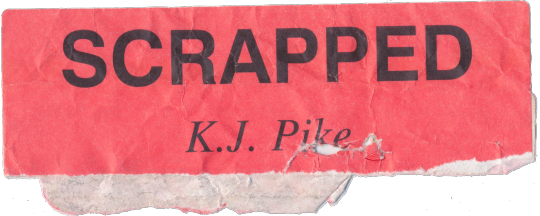
The plates were also covered up with a piece of paper that I found around a while ago. Its a form of tag which was most likely used to detail scrap parts in a yard, by K.J. Pike.
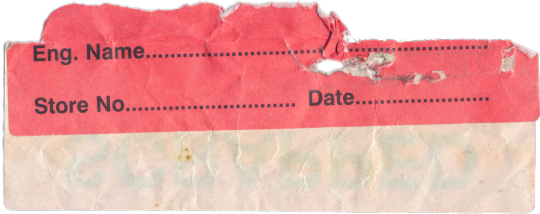
The back features a few options to fill in, mostly in a warehouse setting. K.J. Pike comes up as a company in Blandford Forum that repairs and refurbishes trolleys. Annoyingly I can’t remember where I found it, but I do remember that it was on a rather wet and drizzly day, and it was stuck to the road. I also knew that I had use it at some point for MMV.
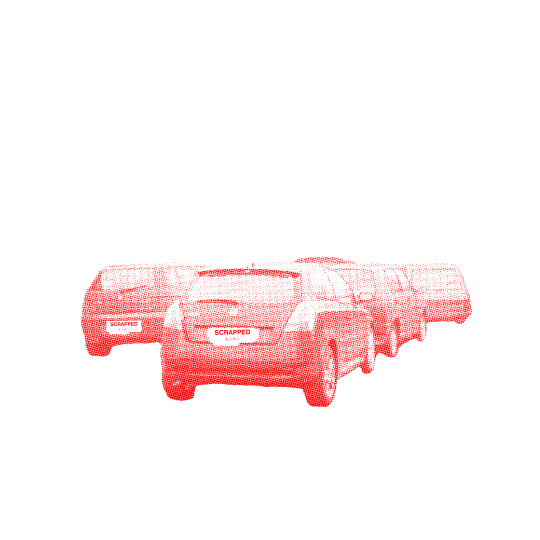
Final Version
There is also a second version which has been edited differently and features no blacks and blends more into the white. For me, I prefer this version purely because it blends more into the whites and the aesthetic is likened to poster design, of which I enjoy. This was created by adjusting the contrast and the lightness of the colouring, with the addition of the ‘scrapped’ tag being merged into the car layer.
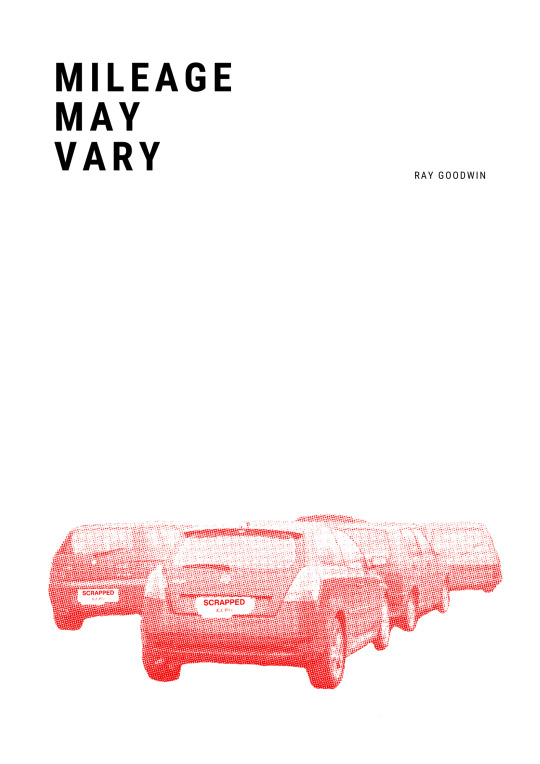
The front cover has been kept fairly clean and clinical. I wanted there to be a lot of white space like a gleaming shopping mall to juxtapose the featuring images, with the cover to represent the entire project in such a way that it doesn’t spell it out - almost having a level of ambiguity to it. I also used Roboto Condensed for all of the writing (albeit minimal) as I rather like the modern sans style font. It also manages to lend itself quite well to the graphic design style of the cover image.
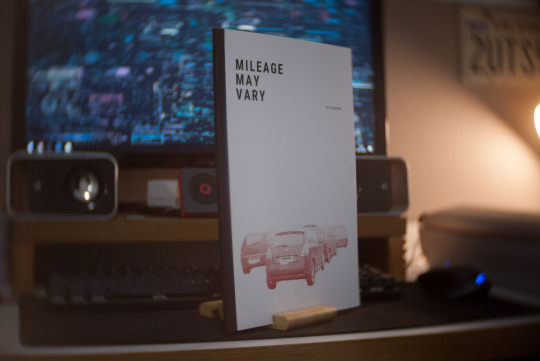
This isn’t just an online zine, it is also a physical one. I wanted to have something physical, as it seemed a shame to not have anything physical apart from a selection of prints. The zine is more of a work in progress publication, rather than what the final thing will look like. I wanted to see how my images work in a physical space, culminated into a small A4 booklet. I decided to print this at The Artside, just so I could have it fastback bound. I didn’t want to have it stapled together, or have it ring bound as I am not a massive fan of both of those options for something that will be a photo book in the end. Stapling the book will make it look like a magazine, and ring binding will make it more of a document. Fastback binding, to me, looks far more professional and sleek, keeping everything clean and low profile. It was printed onto 200gsm satin card with a black card backing.
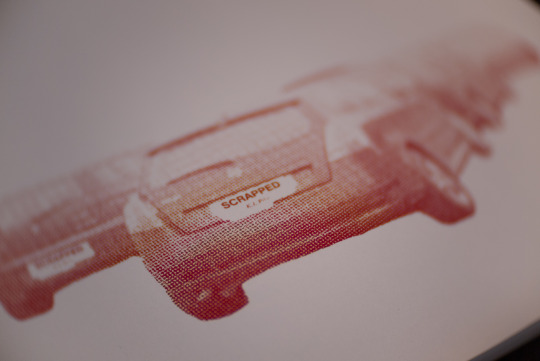
The print quality is pleasing, and perfectly fits the ‘zine’ aesthetic. An example of the front cover here shows the sharpness of the print, in addition to the colour reproduction. The photographs of the zine was taken with my Lumix G1 with a CCTV 25mm F1.4 lens. This lens gives a unique swirly bokeh and the fast aperture of F1.4.
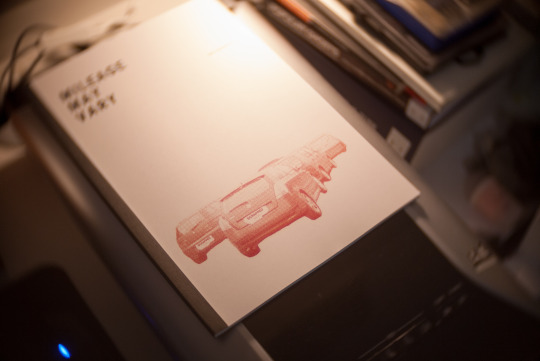
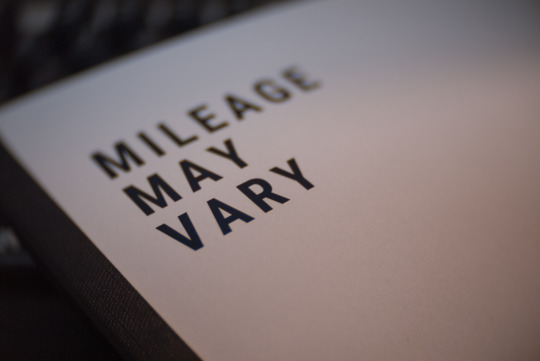
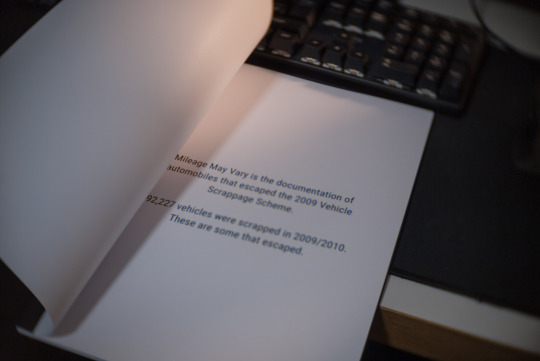

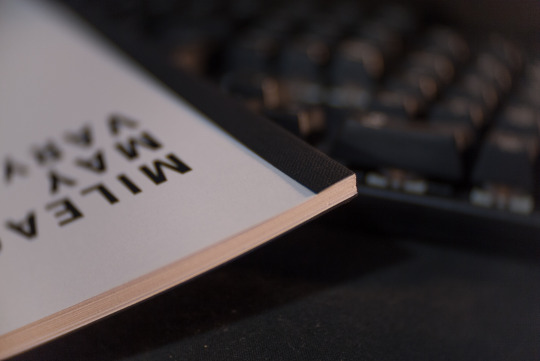
In total, this zine cost me £15 including printing and binding, which I think is a decent price for the end result. Not to mention that it only took around 30 minutes to make, so it was nice to hand in my PDF file, grab a coffee and come back with it all finished and ready to take home. Another bonus to this, is supporting a local business. While it is sometimes nice to order a nice photo book online, I would rather help support local business who still get a good footfall of students come in for there printing - it keeps them in business and provides us with quality products. Whilst this is a good thing, I would also like to invest in a thermal binder somewhere down the line, so I would be able to make my own zines. However, for the time being I am happy to support local businesses and keeping them going. I am also happy with the zines outcome, and I am looking forward to seeing what I’ll be able to create next with the up and coming work flow.
Experimental Journal Plans
The experimental research journal takes on the same form of the zine, in terms of the cover at least. This is to keep a level of continuity within the project. However, I would like to make it more of a manual rather than a journal, and link in some MOT certificate aspects.
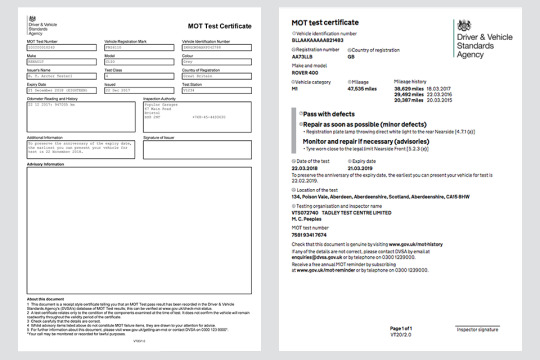
This shows the changes to the MOT certificate back in 2018, with the older version on the left and the new version on the right. I would like to utilise the older version, which would contain details about the shoot/research, with the opposite page showing contact sheets/images and practitioners work. Along with this will be an ‘advisories’ and a ‘reasons for failure’ section detailing things to change and things that didn’t work. These are to reflect the MOT test needed for cars to stay on the road.
The journal will include all shoots, containing the contact sheets and some highlighted images. Practitioners work will also be included with the same advisory and failure sections. These sections will be redacted and kept to a very minimal word count. This blog is very wordy, and I want the experimental/condensed journal to be a cut down version of my shoots and contextual information that advises my thinking. This shall also be created in Canva, following the same front cover and adding the MOT certificate base to form the journal.
0 notes
Photo
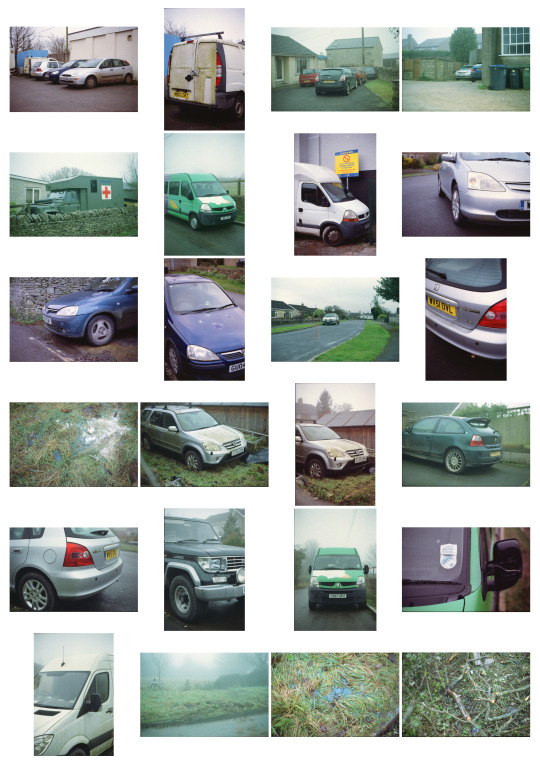
PHOT301 - Mileage May Vary Shoot #6 - 27/12/2019
The fog falls upon the land and covers everything in a fine blanket, obscuring the vision and dampening my clothes. On a dank late December morning, me and Harriet went for a wander around the village to take advantage of the mythical fog, in the hopes to get some good shots, and to document the fallen Citroen Berlingo. There is something about the fog which places an air of mystery to the scene, perhaps because of the mise en scene of motion pictures having an atmosphere to theme. There is certainly a difference between photographing fog in the day, as the background gradually becomes more and more diffused. When at night, the artificial lights from sodium lampposts and buildings shines through, causing halos of light around them.
The EOS-1 was used for this shoot again, as it has become my current favourite film camera to use, and it was the only one I brought with me on the Christmas break. As normal, it was paired with the 50mm F1.8 STM to no surprise. Thankfully, the EOS-1 is partially weather sealed, so the drizzly fog was no bother to me, despite it having a small crack in the body which can potentially let some stuff in. Although it did have this small crack, it was totally fine, albeit slightly soaked. The EOS-1 was loaded up with some freshly expired Kodak Colour Plus 200, which expired in June 2018. I slightly slacked with shooting expired film, and haven’t shot as much as I had wanted to - but one is better than none, right? As it has only been expired for 18 months or so, it won’t have changed much, if at all. It was exposed at 200 asa, and my aperture was set to around F2.2 - 2.5, and the shutter speed ranged a fair bit as the fog took a lot of the light away - I don’t think anything went about 1/250s on this day. Please note, that I scanned this in a weird order, so it isn’t totally in chronological order, the first shot on this roll was taken in Exeter in early December 2019 (white Renault Master and the yellow parking sign).
The walk was rather interesting, as I have never really shot in these kind of conditions before. It seemed a shame to not take advantage of this fog, when it could potentially create some interestingly aesthetic images. In essence, we walked a little loop around the village which took us behind the main housing estate, near farmland and onto the main road.
Days prior, we were sat in the living room and we heard, as well as saw, an air ambulance flying around the village. We thought that obviously something serious had happened, and were quite worried, of course. It transpired that someone caused a traffic collision with a Citroen Berlingo, involving another vehicle. The roads in this area are notorious for causing crashes, and as the weather during the week had been very wet and the visibility was poor, it was inevitable that it could happen - and it just took someone possibly going a bit to fast to find that out. On the 27th, we decided to go out for this walk, and said ‘hopefully that Berlingo will still be there’. Annoyingly, it had already gone, leaving a lot of debris from the collision. Just to add insult to injury, it was still in the field around an hour prior to use walking there, as Harriet’s mother had driven past it before we went out, and it was still there. However, that didn’t stop me from creating some image at the scene.
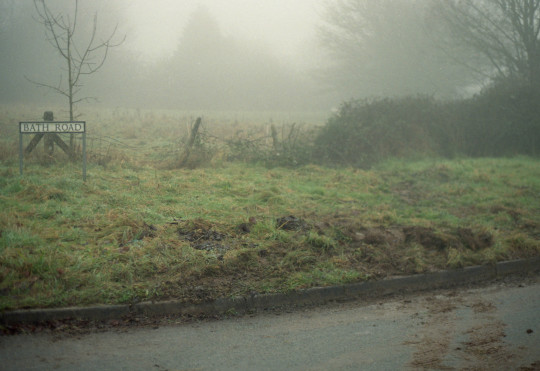
You can see the aftermath of the Berlingo’s path of destruction. By the look of the tracks behind where this was taken, the driver had overcooked it on the left bearing bend, taking out a give way sign, colliding with a second vehicle and then hitting the curb on Bath Road, causing the van to somersault into this field occupied with Geese. The wreckage can thankfully be seen here with this news article - Link.
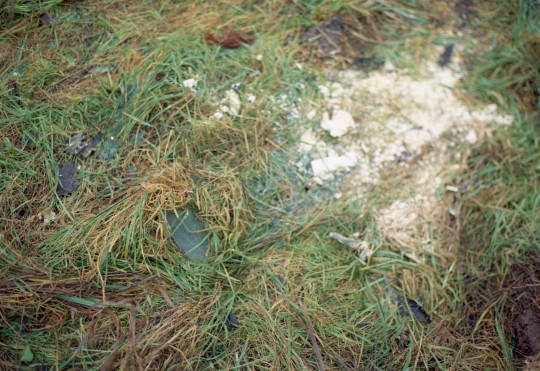
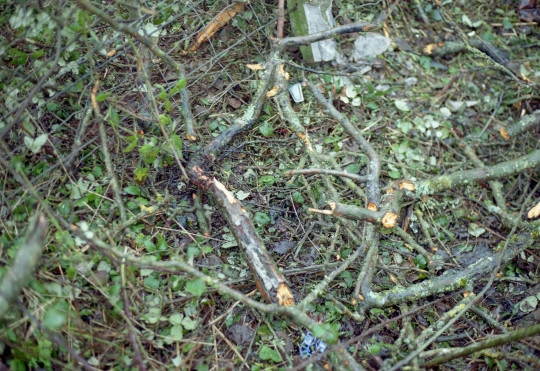
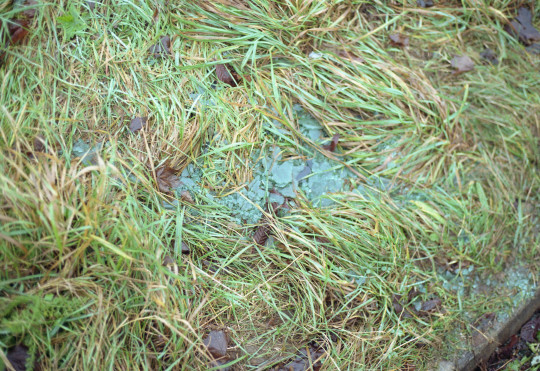
Some more remnants of the Berlingo. The scent of oil and diesel hung in the air, and the glass crunched under our feet. The top photo features some liquid spillage, with some absorbent material applied to the area. The middle image is laden with plastic clips and other related ephemera, with the bottom showing the grass covered in safety glass.
I do like the remnants of the past in these shots. They have a spectrality, as well as a hauntological aspect to them. The area is haunted by the ghost of the Berlingo, and the past that is represented in these photographs, in addition to the photo used in the news article. As time passes, the spectre of this incident will always be omnipresent, additionally with the other incidents that have happened here.
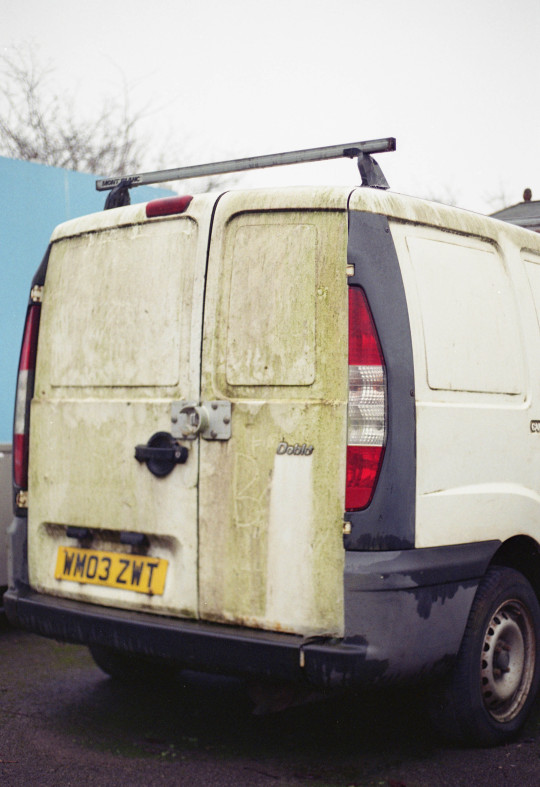
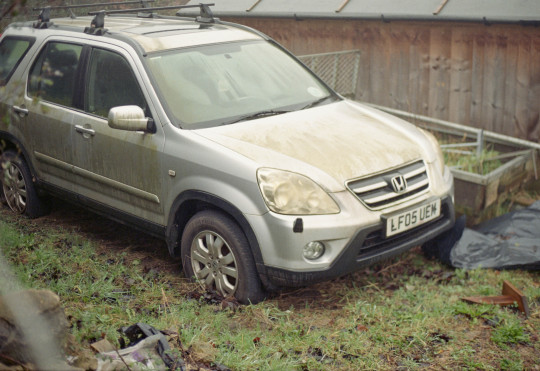
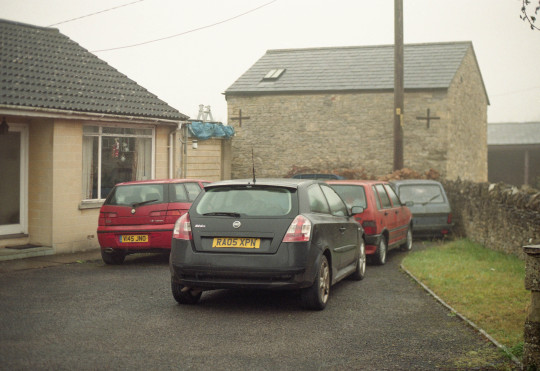
There was no real rationale to what I was looking for, apart from cars older than 2009 with a level of intrigue of their appearance. Thankfully, Colerne features a lot of these kind of vehicles, with mossy paintwork and missing parts. What I found fascinating was the way that the mould grew and was changed by the forms of the Fiat Doblo and the Honda CR-V, especially the Fiat. The name badge totally obscures the growth of the mould, leaving a perfect white space below it where the mould hasn’t grown. This can also be seen with the CR-V, by looking at the offside door handle. I particularly enjoyed the car park of Italian automobiles. Some of these are quite rare now, especially the Alfa Romeo 145 and the Fiat Uno, which are both plagued with mechanical gremlins and poor bodywork issues. I took the same photograph with my Instax 100, but it just didn’t seem to work, just like a lot of those shots. This is where the quality and tonality of 135 film surpasses the Instax of previous, despite it’s inherently larger image size.
This shoot marked the end of shooting in time for PHOT301. Film photography takes time with development and scanning, which adds up when its multiple rolls and the only process for the project. Whilst I hate the trope that film slows you down, I have to admit with all the temerity to say that I do agree. Shooting film has totally changed how I make my work over the years. Since there is a finite amount of images, which also cost money, it makes one think harder about the shot. There is also the ability to not be able to change your ISO during your roll, meaning you’re stuck at that sensitivity until development. The whole process is what makes me come back every time to photograph with it. I do like to shoot digitally for my professional work, but film will always be used for personal projects, which this is certainly that. Something I wish I had more of, is the foggy weather. I did take the 5D out in the fog when I was back in Plymouth in early January, but it wasn’t enough to make up a shoot and wasn’t related to PHOT301, as it was more of a relaxed shooting experience. However, this is now the end of shooting for PHOT301, and anything that is shot after this will be used for the early stages of the FMP.
0 notes
Photo
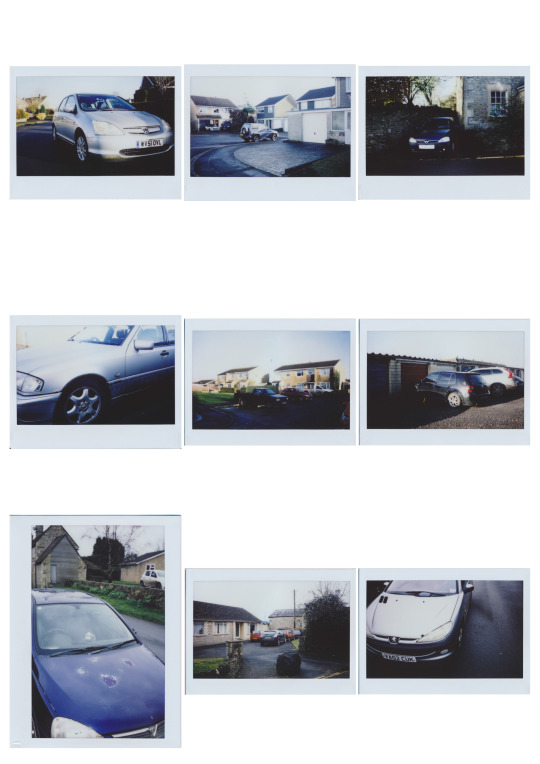
PHOT301 - Mileage May Vary Shoot #5 - 21/12/2019
Now, time for something somewhat different. Since late November, I have been working for Soperfect Images sorting out camera stock in a cold warehouse building in Plymouth. Whilst it is cold and enjoyably lonely, I get to see so many cameras and lenses which certainly fuels my G.A.S (gear acquisition syndrome), which is just an excuse I give myself for being greedy and buying useless things, thinking its worthwhile. One of the things I saw sticking out of a black box was a Fujifilm Instax 100; the first of the Instax Wide cameras, released in 1999. I have always wanted another instant camera, as I had a Polaroid One 600 when I first lived in Plymouth and subsequently lost it in a storage unit.
As I saw the Instax, I knew I had to have it, although it did feel rather cheeky to get first dibs on something that could be sold in the shop. I brought it back to the shop, and managed to get a deal on the camera and a double pack of film for £30 - which included the camera and 20 Instax Wide shots. When the Christmas break came around, this was one of the cameras that I took with me during the Christmas period in Wiltshire. This camera was purchased, more on the premise of a fun photo taking tool, rather than a tool for a project. However, I wanted to experiment with instant photography. There is something about instant photography which is rather interesting to me. Its an analogue format, but ‘instantly’ becomes a physical print. That’s in quotes, as it isn’t entirely instant as some may seem. The prints fully develop within a number of minutes, and the temperature and light levels can change how it develops. It is always best practice to place the ejected image into a pocket until it has fully developed. A lot of people seem to shake Polaroid type images, and that really doesn’t do anything. Going back to the Instax film, this is the Wide variation of the Instax line.
Instax Wide is LARGE in terms of instant photography. The image area measues 6x9, which places it on the larger side medium format. There is also the ‘misconception’ that its also expensive to shoot. Packs of 20 shots usually go for around £16.99, which boils down to around 85p per photo, compared to the £8 per roll of Portra 400 and 8 shots of 6x9, which obviously costs £1 per shot. Despite this, there is much more manual control with medium format cameras, as the Instax 100 features little to no control options apart from a lighten/darken slider. The Instax 100 features a rather bleak aperture of F14, and two shutter speeds of 1/64s and 1/200s. This really forces you to think about the shot, as there are some severe limitations with the locked in settings. The reason for the extremely dark aperture is the film pack is rated at 800 asa. This is so that the flash can be used indoors and get good exposures, just in case you’re at a party or social gathering. This is also backed up by the focus setting always being selected to 0.9-3m.
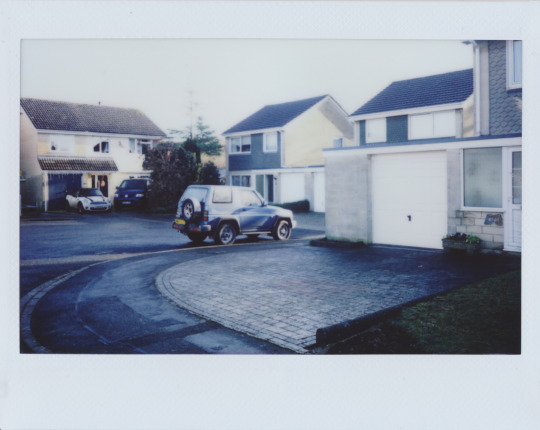
When the exposure us right, the Instax Wide film is quite nice. There is something about the soft ethereal nature of the film which gives the whole image a glow, despite it all being in focus. Its washed out and the colours are very muted, but the highlights are easily blown out and the shadows can easily be lost.
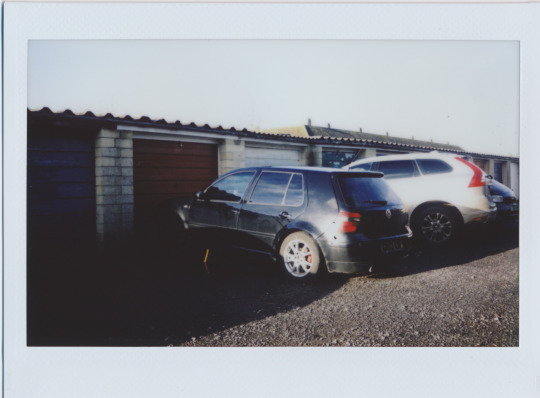
Here is a good example of the dynamic range of the film, as the shadows are almost totally black, and the highlights blow out so much that it goes black. There is a section near the VW Golf’s rear light where the highlights are so blown out, that the film renders it as black spots. This is particularly didn’t want to shoot towards the sun, as it would be rendered as a black hole in the sky reminiscent of a Soundgarden video or a black hole is about to envelop our entire existence. This Golf was parked by a row of garages on axle stands, missing its front wheels. This initially caught my eye as this particular path run through the line of garages, and I had to double take when I saw it, as it is something that is currently out of action and worked on - who knows what has happened to it and the reason to why its on axle stands. I really do love that level of unknowing and ambiguity of something, leaving the viewer to interpret or even guess what is happening in the scene.
Is shooting Instax Wide a viable, continuable option to shoot for this project? No. Whilst its good fun to shoot, it is not financially applicable and aesthetically detracts from the slew of sharp 120 and 135 format film scans of previous. There is a way around this, and its removing the Fujinon lens included with the camera and placing on a totally manual lens, from either a Mamiya Press/Polaroid 600SE or large format cameras. This is because the lens has a shutter speed, as well as the aperture. This would give the user total manual control and be able to ultilise the 800 speed at varying shutter speed and aperture combinations. However, this would take come considerable time, effort and practice to get it right. Whilst I am confident with tinkering with cameras, I am not as confident enough to force a lens onto something which has the potential to take chunks out of my bank account upon experimentation. Whilst I do like the option to make a lens work with manual controls, I do like the aesthetic and creative limitations that the original lens offers.
As there are some serious limitations, it makes one think more about the shot and if it will even come out onto the print. It does take some consideration and knowledge of manual controls to think whether the image will be properly exposed, or one can totally forget that and apply the ‘don’t think just shoot’ mentality of Lomography. It’s one of those things which takes a special time to be able to shoot it properly, as the physicality of the image is a lot more meaningful than a digital scan of an analogue image. The aesthetic also does not fit my current workflow, as it juxtaposes the sharp and bokeh-laden photographs of MMV with soft, ethereal pastel prints. These were more of an experimentation with a different process, more than anything to keep things fresh and new. It also has given me a new found appreciation for Instax film and shooting in general. Motivation is a hard thing to come by, and it often comes around in waves. I have enjoyed using an instant camera, but I can’t see myself using it for more than some fun.
0 notes
Photo

Brutal and Banal Landscapes - An Exhibition
Exhibiting work can be very daunting, and something that not many undertake outside of their course. People are able to see work publicly, being shown on the wall for all to see. But why is this so daunting when you can post the same image on Instagram for arguably more people to see it. Perhaps its the lack of real, human engagement compared to looking at a mobile phone. This is where Brutal and Banal Landscapes comes in. B&B is an Instagram account that me and Harriet run which showcases newtopographic style photography from numerous Instagram users. It amassed a good amount of followers and incredible engagement with a certain community of photographers. This served as the basis of the exhibition that me and Harriet planned during the second week in November. There was a call out for exhibiting work in Project Space One. This could be anything that we want: we just had to fill out some health and safety forms and a proposal. The poster was made with Harriet’s excellent graphic design skills featuring one of my photographs from PHOT201′s Alienated Spaces. This exhibition featured mainly work from year 2 on both accounts, with my Alienated Spaces project, and Harriet’s Curiosity of the Mundane.
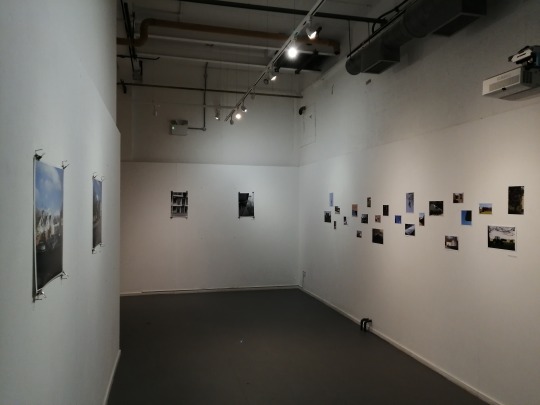
Project Space One is a lot larger than we originally anticipated, and we both had different ways of exhibiting our work. Harriet chose for more of a mind map style of placing the work onto the wall. It manages to follow a flowing line across the wall, whilst also being a sporadic mass of images. I chose a fairly mundane style of exhibiting, of just have two sets of two next to each other. I also chose to maximise the wall space by splitting up what I had onto two walls, leaving less unoccupied space.
Harriet’s images were simply nailed to the wall, with a nail placed in each corner of the print, leaving the nail exposed. Her rationale for this style of exhibition was to mimic the look of family photos being placed on the wall at home. Home is often a banal and mundane space, which most people live in everyday. With this, it turns that on it’s head and displays the scenes of the everyday, in the style of family photos. Whilst the exhibition was in PS1, Robert Darch dropped in to drop off a copy of The Moor as a donation for the Print Auction. Whilst he was there, I showed him around the exhibition. Thankfully, he very much enjoyed what we had created and curated.
There were some teething issues initially with the space, as the previous tenant of PS1 left screws in the wall, as well as not changed the lights to how they should be, leaving us to arrange that being changed. Another annoying thing about the space was the difference in light temperature. Above, you can see some of the lights are warm, and others are cold, giving a very mixed temperature to the images. I am not sure why they have different bulbs, but if we would have known before hand we could have changed that.
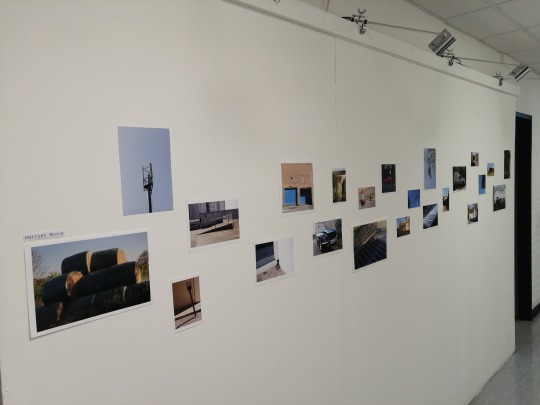
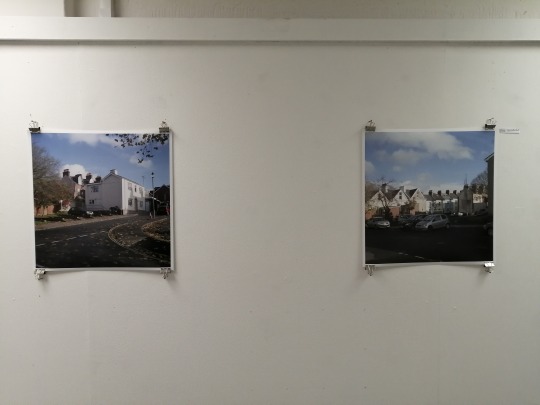
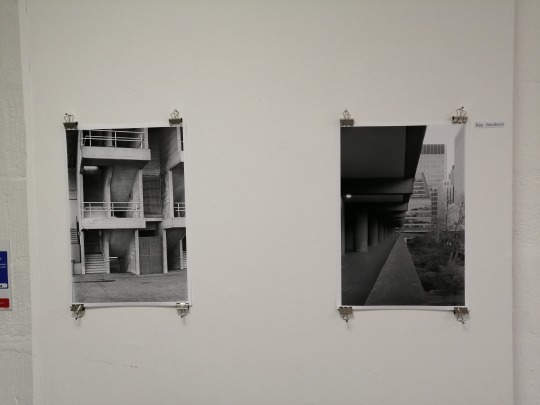
Right after the exhibition finished in PS1, it was immediately moved to the corridor in Photorgraphy. The photographs were placed on the way in the same way that they were in PS1, with Harriet’s being nailed directly to the wall, and mine utilising bulldog clips and nails to preserve the prints, as I intent to use them for the upcoming print auction.
This mini exhibition has taught us many things, mostly how to curate and place an exhibition by ourselves. It seems that other members of the cohort haven’t yet initiated this kind of action, so it gives us the advantage when it comes to exhibiting work outside of the classroom. It was also good to hear so much feedback on our work, with it all being positive and constructive. It is certainly something that we will do in the future, and it to be used as a learning experience.
(note - the prints were up until January 15th, before the 301 deadline)
0 notes